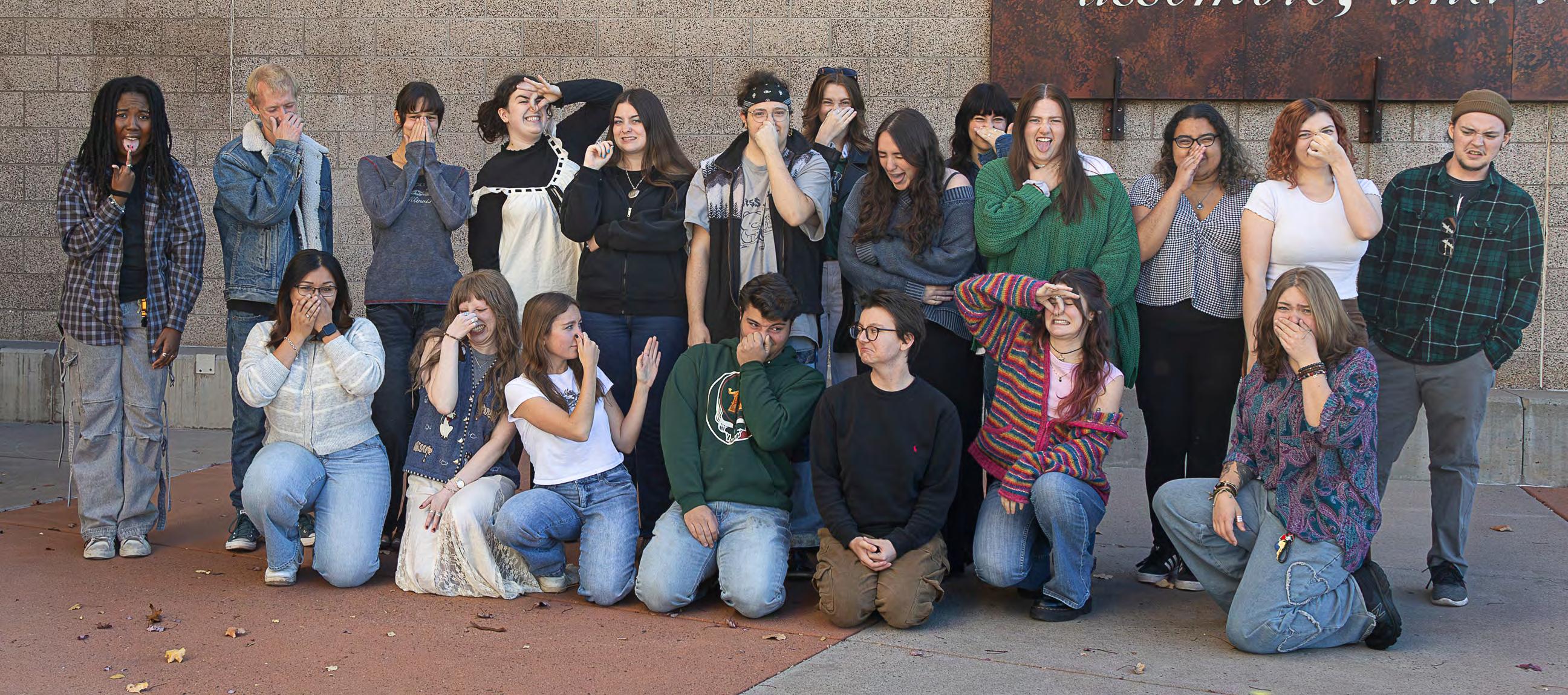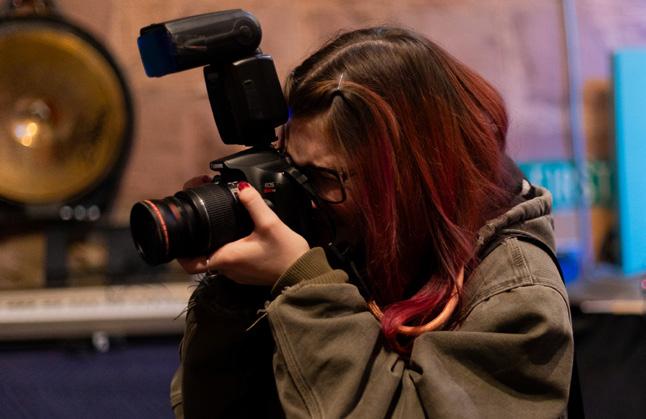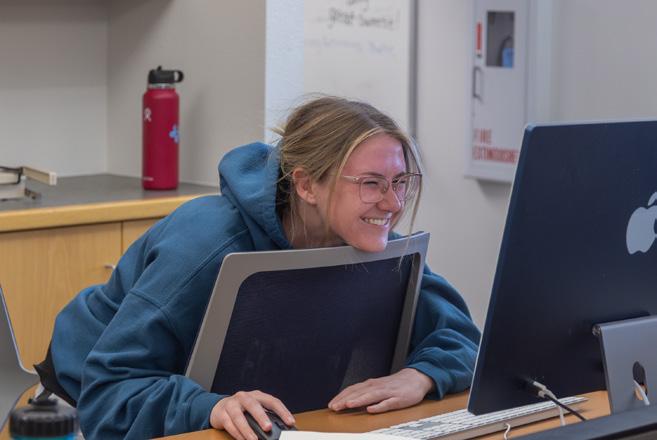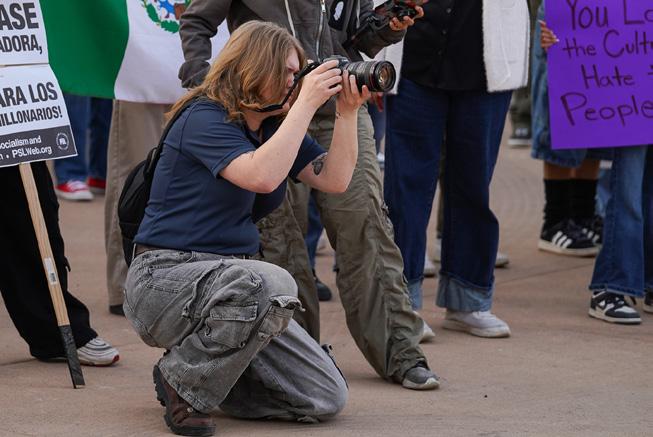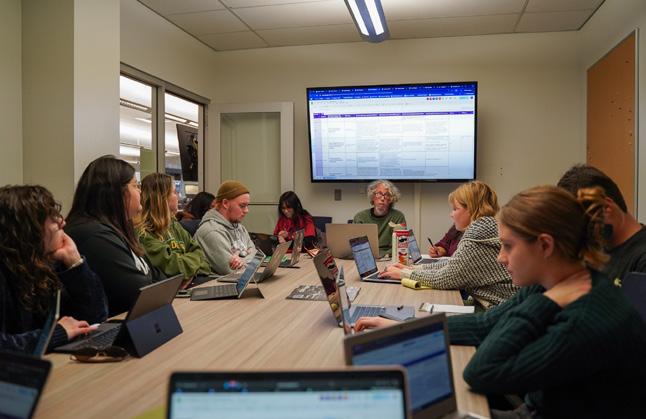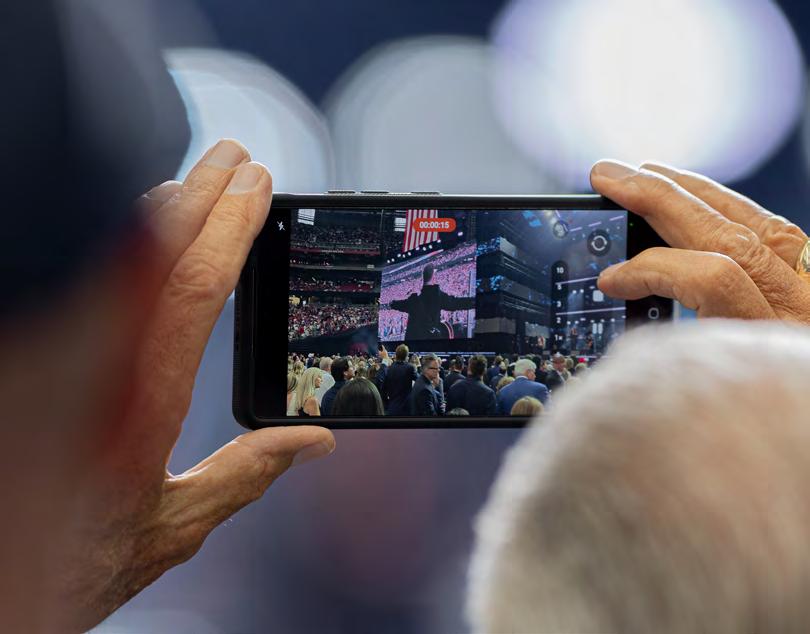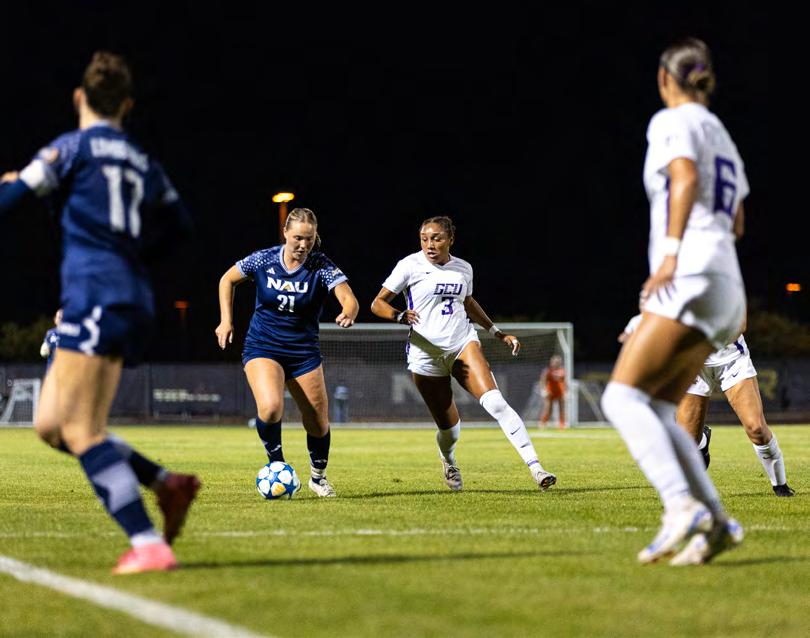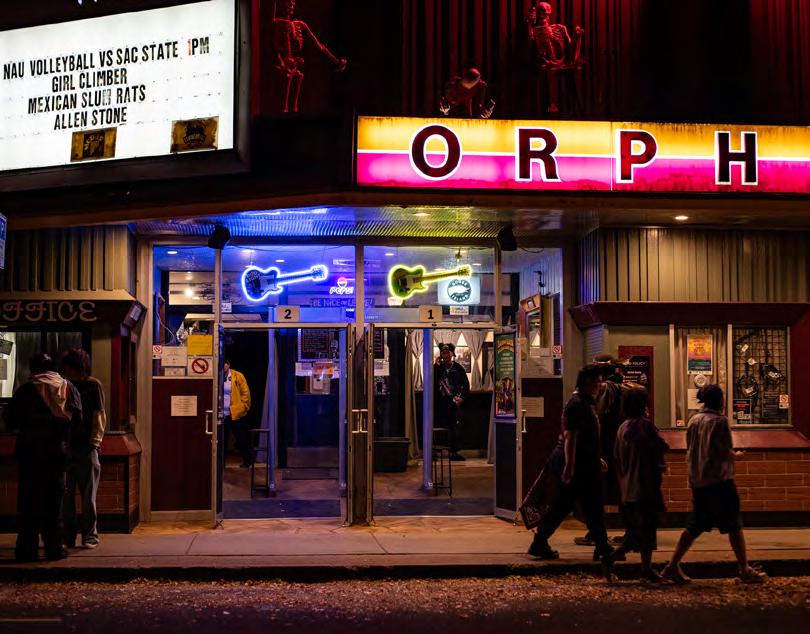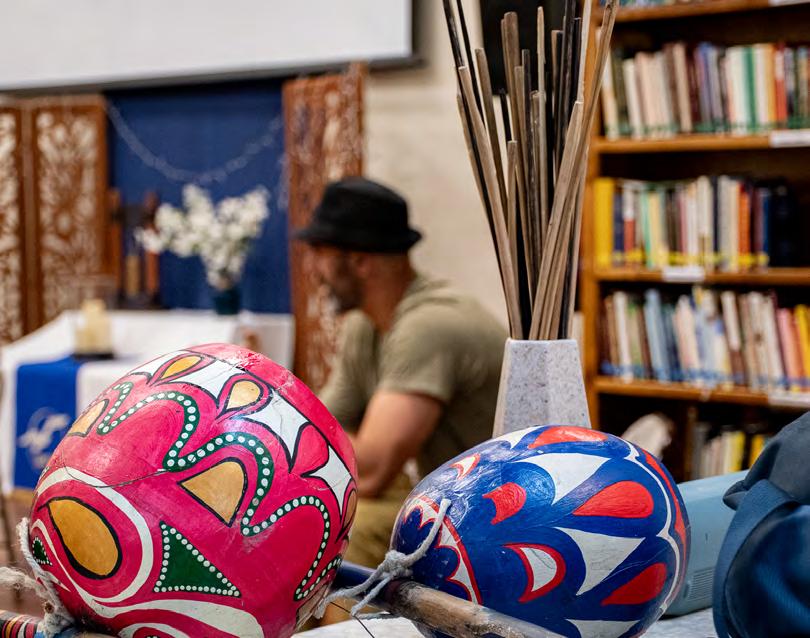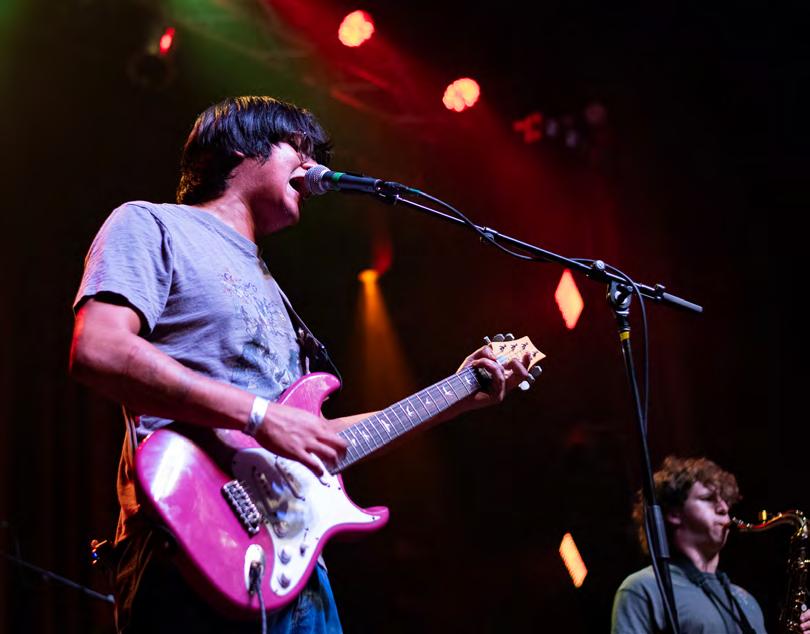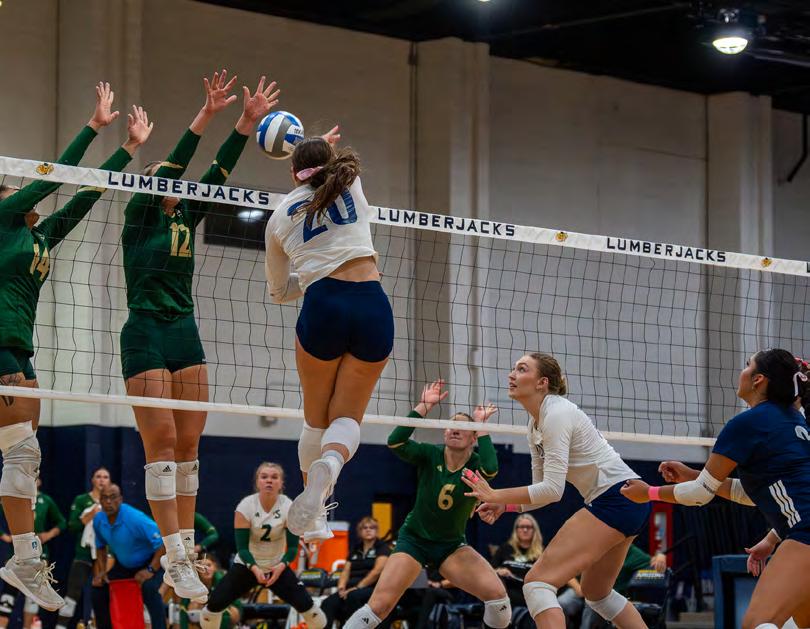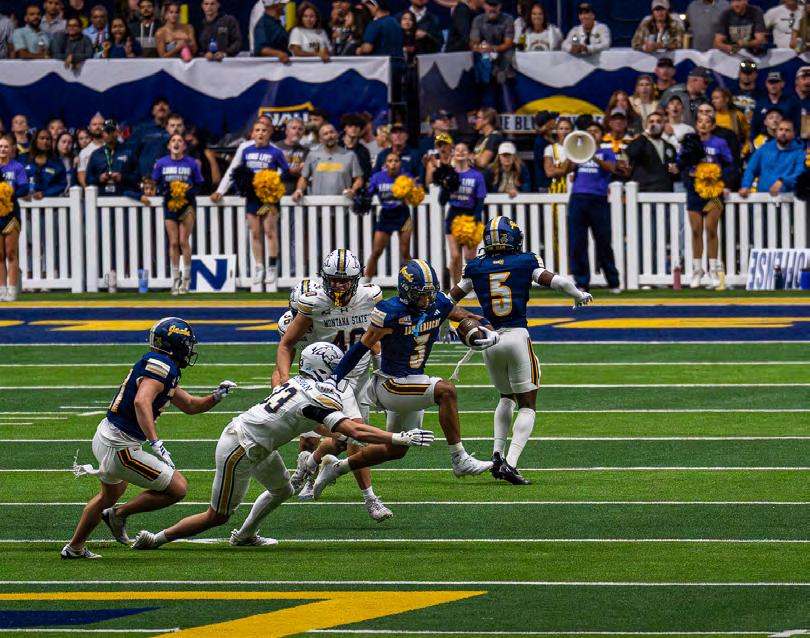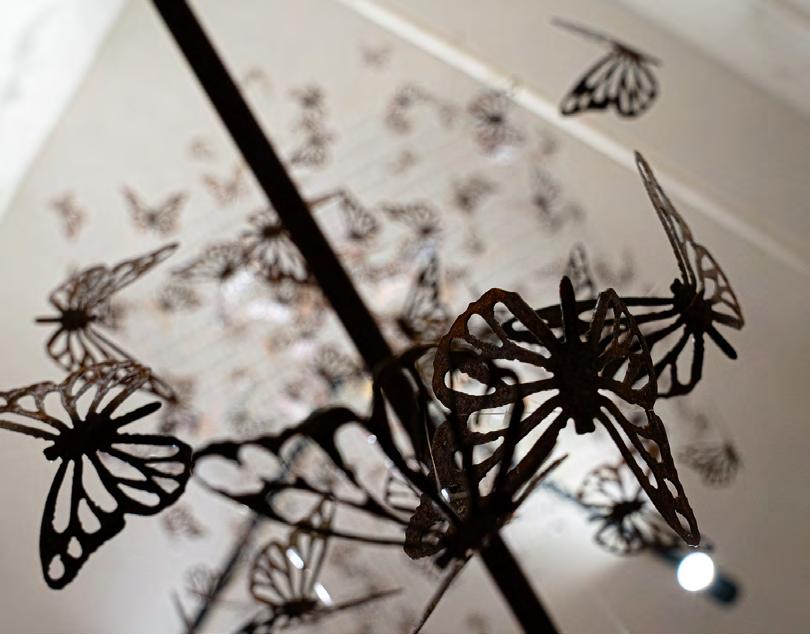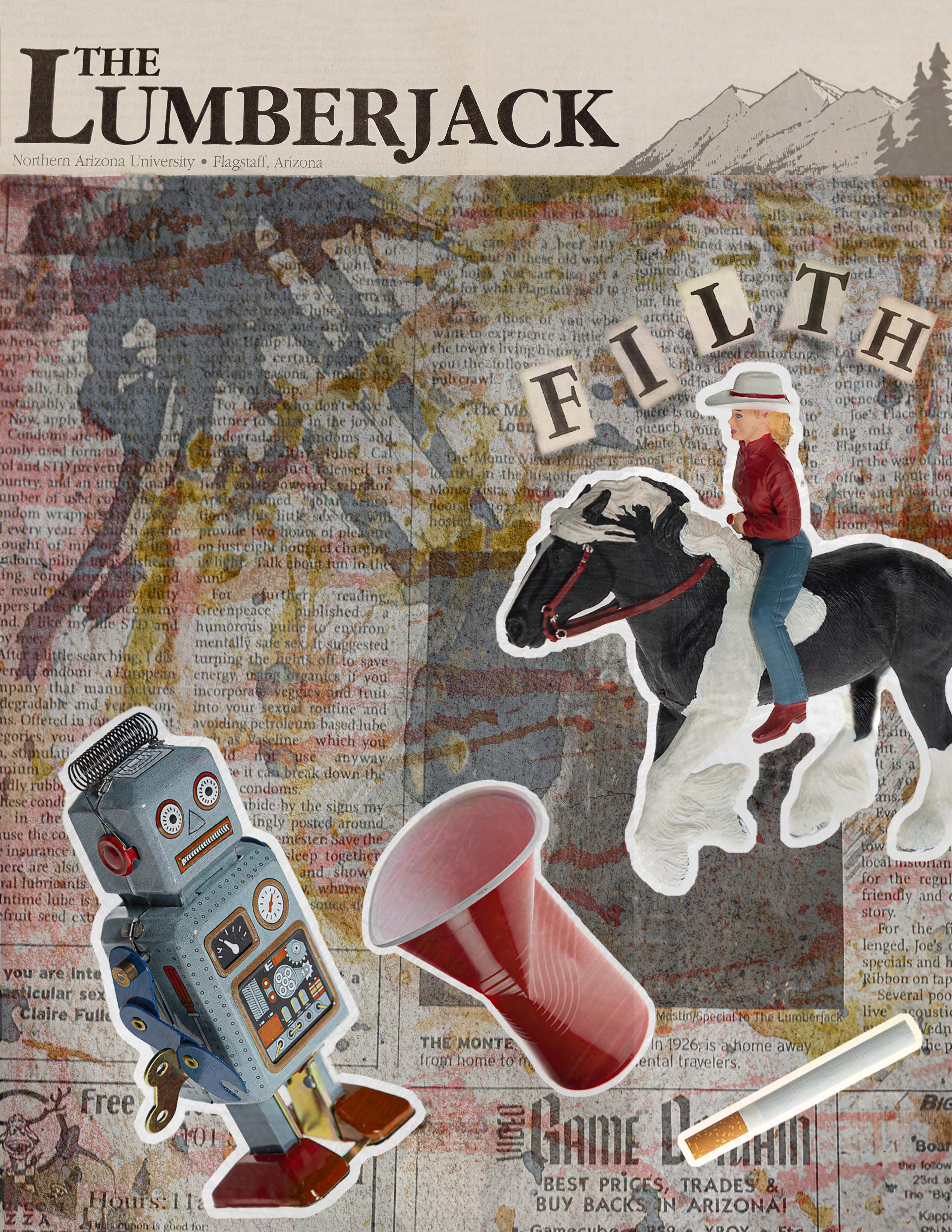
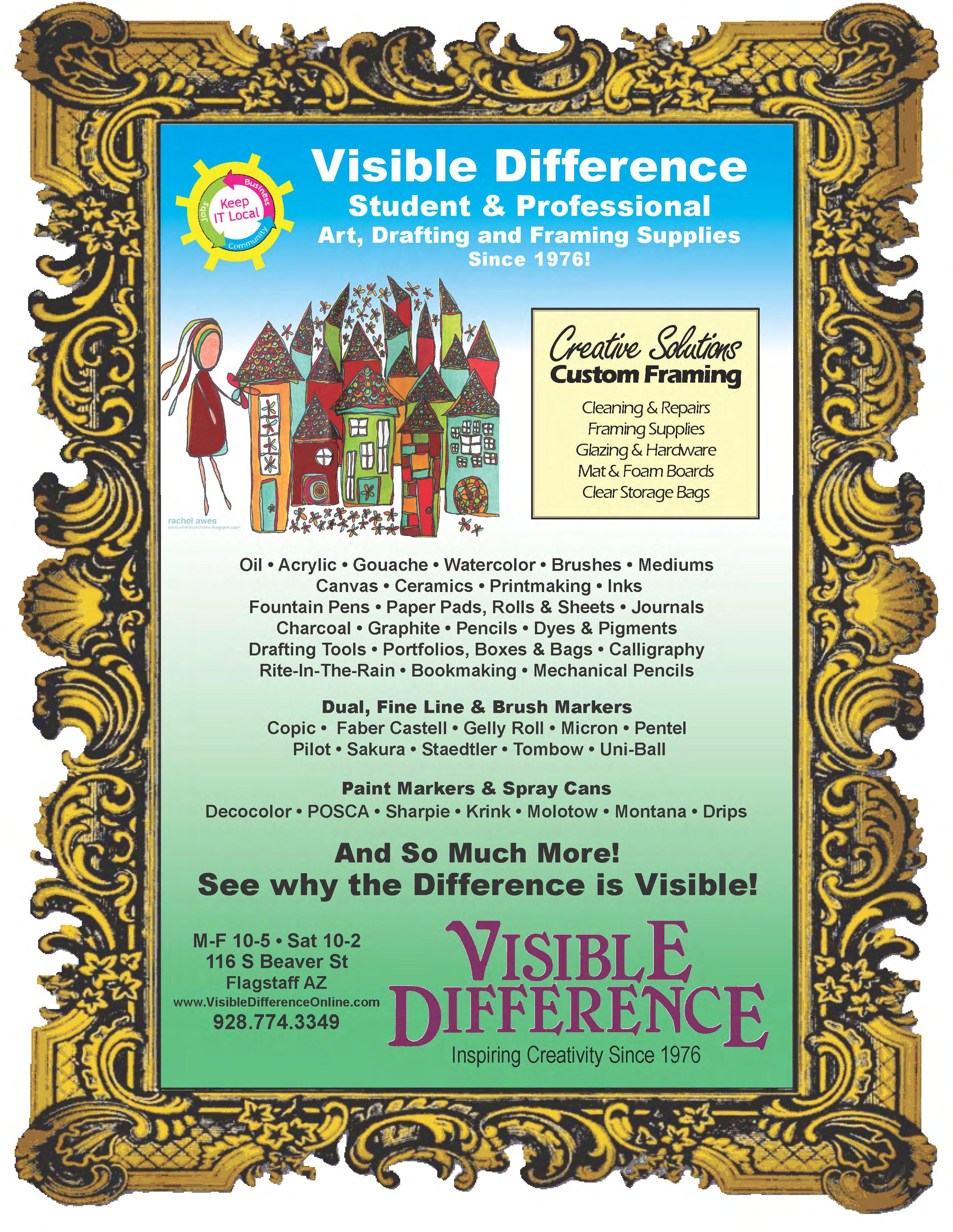



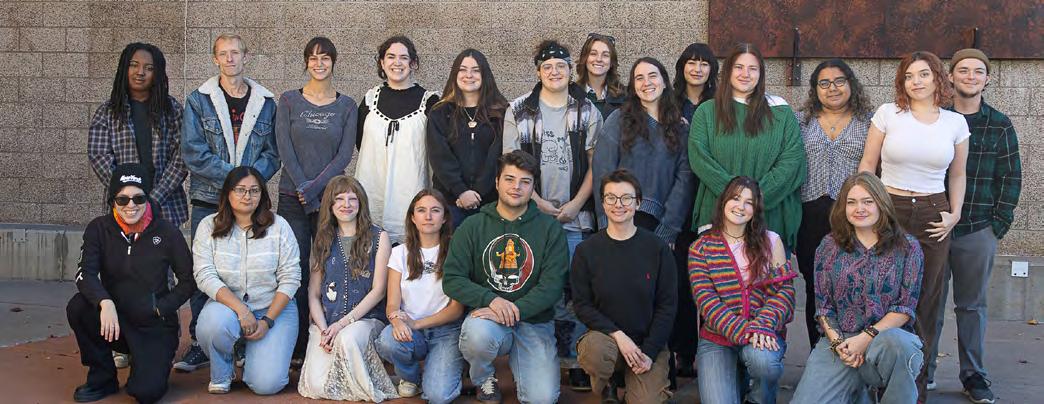
Leo Diven Legay, Editor-in-Chief
Ava Hiniker, Managing Editor
Jason Maggio, Director of Digital Content
Corey Stakley, Copy Chief
Sara Williams, Director of Social Media
Emma Stansbery, Director of Print Design
Morgan Felker Lewis
Marcel Herving
Molly Hunter
Emilia Mena
Mason Robles
Abbey Sobelman
Saige Steele Elliott Stringer
Katie Tsoukatos
Darby Walker
Sara Williams
JL Arnold III
Murphy Elser
Grace Herzig
Tanner Johnson
Tegan Kelley
Rosela Limas
Jesenia Mackey-Tarango
Sarah Manning
Yanissa Romo
Sierra Schafer
Beck Toms
Vivien Volkov
Haleigh Williams
Katherine Locke, Faculty Adviser
Northern Arizona University sits at the base of the San Francisco Peaks, on homelands sacred to Native Americans throughout the region. We honor their past, present and future generations, who have lived here for millennia and will forever call this place home.
Phone: (928) 523-4921
Fax: (928) 523-9313
lumberjack@nau.edu
© 2025 The Lumberjack
P.O. Box 5619 Flagstaff, AZ 86011
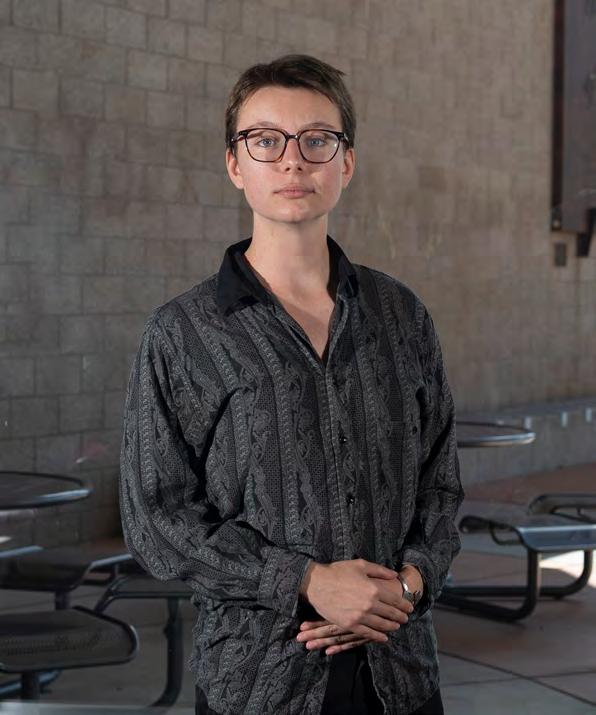
LEO DIVEN LEGAY EDITOR-IN-CHIEF
“Filth is my politics! Filth is my life!”
— Divine, “Pink Flamingos”
Whether they trudged through garbage piles for the perfect photo, interviewed scientists who study bat guano and fungal infections or braved the sweaty, gritty crowds of local punk shows, our staff rolled up their sleeves and got their hands dirty for this semester’s magazine.
“Filth” goes beyond the surface-level with stories exposing the dangers of sexual abuse, environmental desecration and cigarette addiction. The topics we focus on in this issue might not be clean, but they all affect the NAU student population. College is a messy and complex experience, a time rife with turbulence. As a studentrun publication, we wanted to create an issue that speaks to us and our peers.
What is filth? You know it when you see it. The Lumberjack has a storied history of digging up the proverbial dirt. From exposing university president scandals to exploring Flagstaff’s BDSM scene, we have always gone beyond the clean exteriors of our surroundings. Filth is sex, grime, ash, disease, pollution – things that we see and hear about every day but shy away from discussing. This is why we chose it as the theme of this issue.
The Society of Professional Journalists’ Code of Ethics says our primary job as journalists is to seek truth and report it. In a sense, filth is truth. Some of our stories take pristine-seeming ideas, like the conservative ideal housewife or one of the founding families of Flagstaff, and bring their bitter truths to light.
I am immensely proud of the work our staff did on this magazine. They each stepped out of their comfort zone to create strong, creative, newsworthy work.
Thank you to our faculty adviser, Katherine Locke, who always teaches us to balance on the fine line between passionate writing and journalistic ethics. She leads with a firm yet welcoming hand, always pushing us to reach our full potential.
Additionally, I want to thank Emma Stansbery for stepping up to the task of designing this magazine and leading much of its production. Vivien Volkov and Haleigh Williams also stepped up last-minute to co-head our illustration team, which is a necessary asset to this magazine’s overall look. I am eternally grateful to you all for your dedication.
Finally, I want to thank all of our editors, reporters and visual staff for their work. Please take some time to look at every name on our contributors list. Despite balancing our regular news coverage, school work and personal responsibilities, we all dedicated a significant amount of time and effort to creating this magazine.
Cover composed by Beck Toms
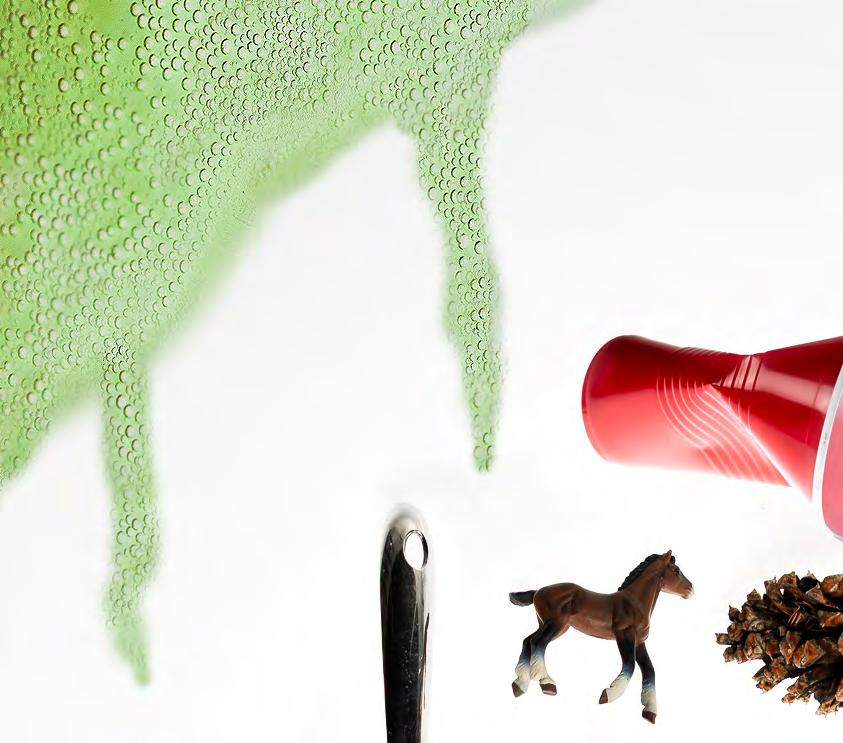
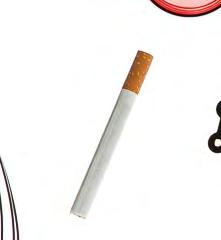


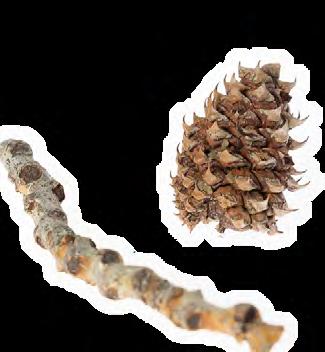


Fungi, guano and plague: NAU’s Pathogen and Microbiome Institute
Welcome to campus! Beware the Red Zone
Why we’re obsessed with being disgusted


Carving away the lives of aspen trees
What’s wrong with a cigarette?
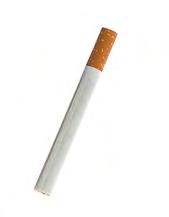




Memories from the Margins: The Riordan Family Uncensored
AI and image-based sexual abuse The ‘right’ kind of women Ragin’


15 mockups 38 layers 13 individual pictures
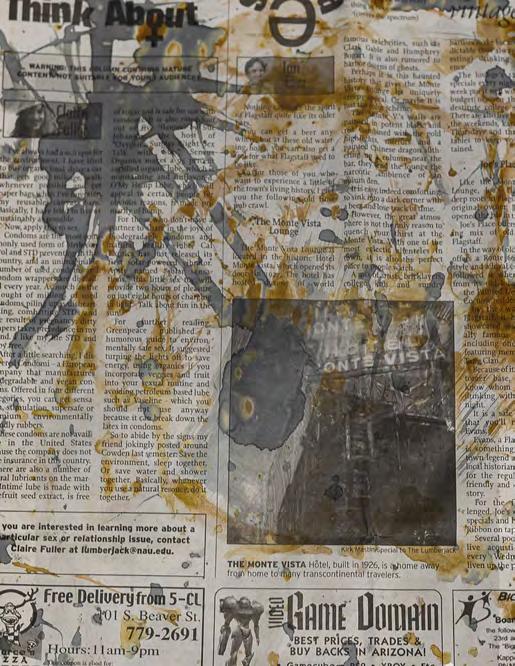

One Feb. 18, 2004 issue of The Lumberjack splattered with cyanotype and Van Dyke brown chemicals
Column by Leo Diven Legay
Editor’s note: This piece contains mature content and a reference to sexual assault, which some may find disturbing.
As promised to our faculty adviser, this article is not a sex column. It is, however, a reflection on The Lumberjack’s history of sexrelated stories and the reactions we have received.
Writing about sex, especially as student journalists, is a complicated endeavor. On one hand, sex is part of the human experience. However, as a news publication that reaches readers of all ages, we must know where the line is between informing and graphically sensationalizing.
Looking back at our previous coverage can help us see when we delicately approached that line and when we crossed it entirely. Our past issues also serve as an archive of what mattered most to previous generations of college students.
The earliest mentions of sex in The Lumberjack coincided with the sexual revolution of the 1960s and 1970s. Premarital sex, sex education and contraception were thrust into public discourse as the women’s liberation movement thrived.

One masthead from 1998 “Filth” story easter eggs, photographed in the NAU photo studio (find them throughout the magazine!)

The cover of FILTH!

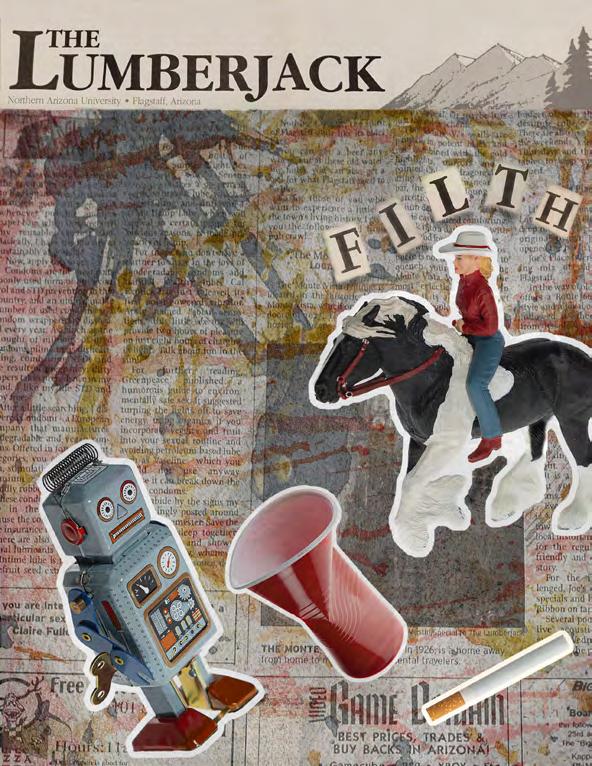
Some of our campus coverage and published “Letters to the Editor” during this time focused on NAU’s curfew for female students. Women attending NAU and living on campus could not leave their dormitories between certain hours of the night. In 1972, Title IX was passed, and many of the harsh curfew restrictions were removed.
However, some remained, prompting Cowden Hall resident Amy Harris’ letter to us in 1979 titled “Women have rights too; visitor, desk clerk won’t get raped.” Harris discussed the double standard of women being punished for having male companions in their dormitory buildings, while men had little to no consequences for having female guests in theirs.
“There seems to be no quarrel with men being permitted to have a full-time companion, yet the deans are worried about females being defenseless creatures, unable to rationally choose the proper company to keep,” Harris wrote.
In the 1990s, The Lumberjack’s coverage reflected the time’s raucous, grungy college culture, with sex becoming a major topic.
The article “Students talk sex for Playboy survey,” published on Aug. 28, 1996, discussed the sexual habits of college students. The piece addressed how students approached sexual health as members of the “first AIDS generation,” noting the prevalence of condom use and HIV testing among students nationwide.
In our Dec. 3, 1997 issue, we published “Changing positions on sex,” a news story discussing college sex trends that elicited a number of horrified letters. The piece included a list of “Top 10 public places to have sex on NAU campus,” comprised of results from an informal survey by The Lumberjack. Along with the article were photo illustrations depicting students in intimate positions around campus.
The piece was met with mixed reception, with one reader saying he read it with “voyeuristic pleasure,” and others describing it as “uninformed,” “immoral” and “really just filth.”
Read the rest of this article on jackcentral.org/magazine

Story by Morgan Felker Lewis
Photos by Sierra Schafer

Dressed in lab coats and latex gloves, the scientists inside NAU’s Applied Research and Development building walk carefully around their second- and third-floor laboratories. Biohazard freezers and beakers line the taped-off sections differentiating lab clearances, each one prime to store all things contagious, chronic and clumpy.
The Pathogen and Microbiome Institute (PMI) is a world of ecology and evolution. Scientists come together from different departments across NAU to create a powerhouse of research focused on infectious diseases, environmental science and immunology.
Faith Walker is an associate research professor who specializes in wildlife biology, conservation and genetics. Walker has worked on NAU’s Species from Feces project for 12 years and has helped develop a genetic tool that can identify bats through their fecal samples.
“People send us guano from everywhere, and we can tell them what bat species are using that roost of interest,” Walker said. “We have a lot

of projects having to do with Species from Feces, and now it’s kind of blossomed into anything that poops.”
Walker’s team collects samples locally and worldwide; anyone can send a fecal sample to the program for genetic testing. Scientists then deduce the animal’s diet and the composition of different bat communities across various caves, hollow trees and crevices.
This research has led to the discovery of a new bat species in Arizona: the Mexican long-nosed bat, or Leptonycteris nivalis. The bat was previously only known to leave its habitat in Mexico to migrate to Texas and New Mexico for mating purposes.
Walker and her team were swabbing hummingbird feeders when they discovered a DNA sample from the nectar-eating bat in the Chiricahua Mountains.
“That had huge conservation implications, and that work is still ongoing to try and figure out how far they occur in Arizona and what their distribution is,” Walker said.
Walker also co-founded the Ancient DNA Lab, located in the Bilby Research Center, which dates ancient specimens. This lab’s specimens require complete isolation from modern DNA. Its research team has worked with mammoth fecal samples, a 13,000-year-old bison jawbone and mummified bats from the Grand Canyon that average 30,000 years in age.
“Basically, we put an enzyme in solution with some buffers, and we digest the material,” Walker said. “That kind of gets everything ground up, and then we go through a series of adding buffers and using a filter to basically end up with purified DNA.”
David Wagner, PMI’s executive director, NAU alumnus and biological sciences professor, primarily conducts research on Yersinia pestis, otherwise known as plague, in local prairie dogs and the evolution of ancient infectious diseases.
He decided to pursue his doctorate at NAU after conducting undergraduate work with Paul Keim, the founder and former executive director of PMI.
A refrigerator with a biohazard sign on it contains samples from experiments inside the Applied Research and Development building. Sierra Schafer
Plague is transmitted through animals like fleas or rats. Wagner conducts research in Madagascar, home of some of the highest infection rates of plague, to test new treatments for the disease.
“We use DNA fingerprinting to understand the different types around the world and then how it’s spread from one location to another location,” Wagner said. “We’ve advanced diagnostics and the understanding of things like pneumonic plague outbreaks that are very rare outside of a place like Madagascar, so by characterizing those, we’re able to understand these rare events that don’t happen in the U.S. but we’re concerned about from a bioterrorism standpoint.”
Bioterrorism is the act of releasing infectious diseases into the environment to cause massive harm to a population. In 2001, when letters laced with anthrax began appearing in U.S. mailboxes, Keim helped the U.S. government investigate the diseases’ source by providing research from Los Alamos National Laboratory and his lab at NAU.
This research led to increased funding, which helped Keim found PMI officially.
Wagner said he started working at NAU because of Keim’s DNA fingerprinting system; in the summer of 2001, he used the system to study local prairie dogs that were rapidly dying of plague. The PMI lab
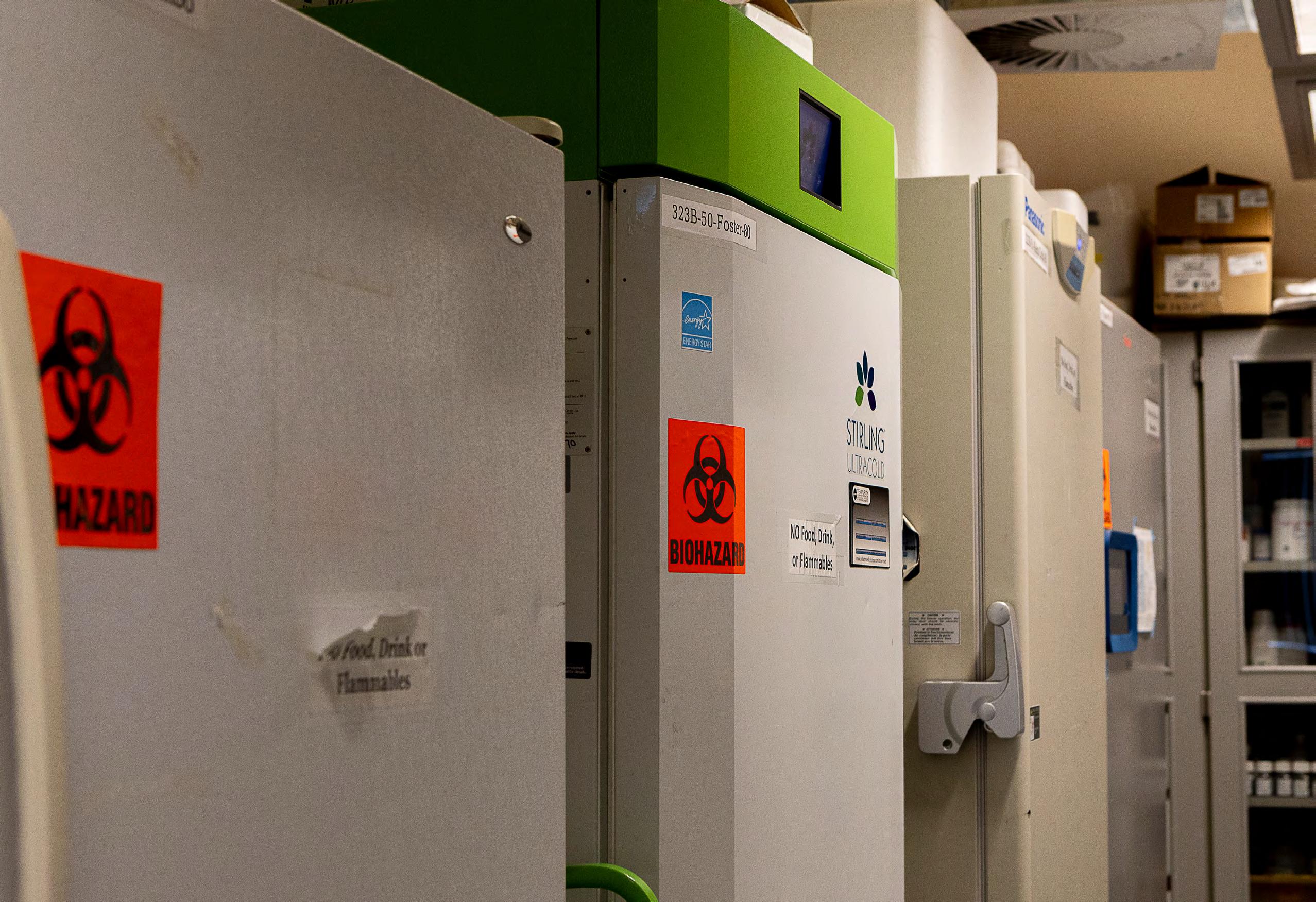
With the case of pathogens, I think we always think about the negative side, but I think Coccidioides is just trying to survive in the environment. It just so happens that, potentially, the niche of the lung is beneficial for the organism.
also researches the evolution of plague and studies samples from more than 1,500 years ago.
He said when he is working with ancient skeletal specimens, teeth can be a DNA time capsule. Once a sample is taken from an ancient tooth, researchers can create a family tree of current and past strains, connecting them back to three separate major pandemics that all came from ancient Central Asia.
“We are able to go back in time,” Wagner said. “Study the evolution, and then you can sort of infer that from the family tree, too, just like you would with the human genealogy.”
PMI has an expansive sample collection that includes a range of infectious diseases, such as COVID-19, anthrax and Coccidioides.
Bridget Barker, biological sciences professor and PMI member, specializes in Coccidioides, or the fungus that causes Valley Fever. This fungal disease is transmitted when one inhales Coccidioides spores, which can enter the environment when one agitates or disrupts soil that contains them. Valley Fever is commonly found across the American Southwest, Central America and eastern Washington.
In 2014, Barker helped discover Valley Fever’s presence in eastern Washington. She is now conducting research on whether or not the climate in eastern Oregon could also support this disease.


Arid regions with only a few days of below-freezing temperatures per year, low precipitation and higher soil temperatures are best suited for Valley Fever to thrive. Barker said these conditions create a perfect environment for the disease to develop.
“With the case of pathogens, I think we always think about the negative side, but I think Coccidioides is just trying to survive in the environment,” Barker said. “It just so happens that, potentially, the niche of the lung is beneficial for the organism.”
The endozoan hypothesis, co-created by Barker, states that Coccidioides is not parasitic and challenges the preconceived idea that this disease intentionally infects people.
In Brazil, Barker is conducting research at the University of Brasília to investigate a possible Valley Fever outbreak in prairie dogs. She discovered new species of potential human fungal pathogens and has also researched Aspergillus fumigatus and its devastating effects on the immunocompromised.
A weakened immune system can allow Aspergillus to become deadly, despite humans being exposed to it on a daily basis. Barker learned how to manipulate and mutate genomes to further understand how to fight this fungus.
PMI’s scientists and undergraduate students work to further research endeavors in the scientific world through hands-on lab work and grant funds. Through this evolutionary, learning-based, ecological and genomic research, they can provide the world with further understanding of infectious pathogens, whether they deal with ancient diseases or modern-day outbreaks.
: Associate research professor Faith Walker poses for a photo. Bottom: Lab materials inside a display in the Applied Research and Development building.
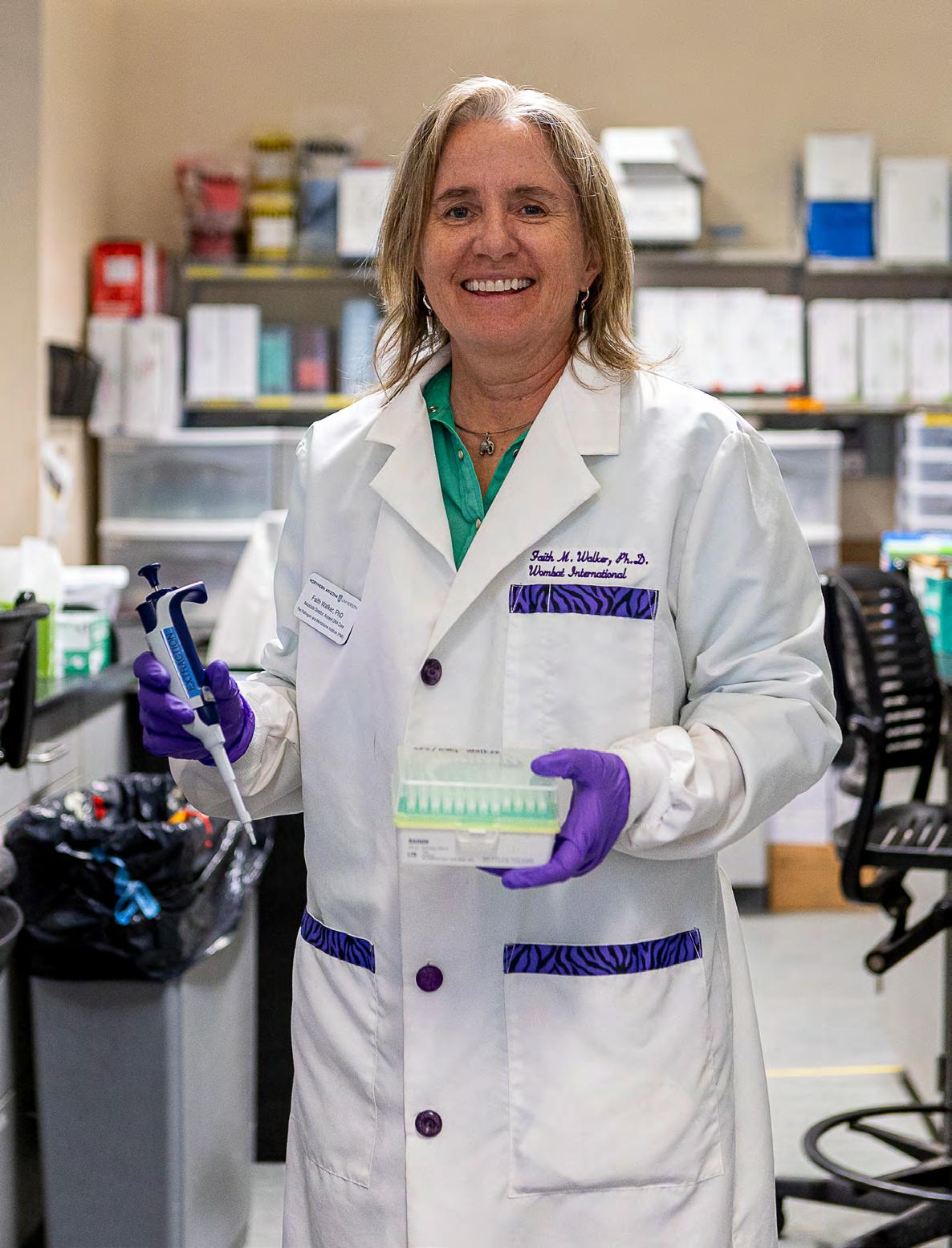
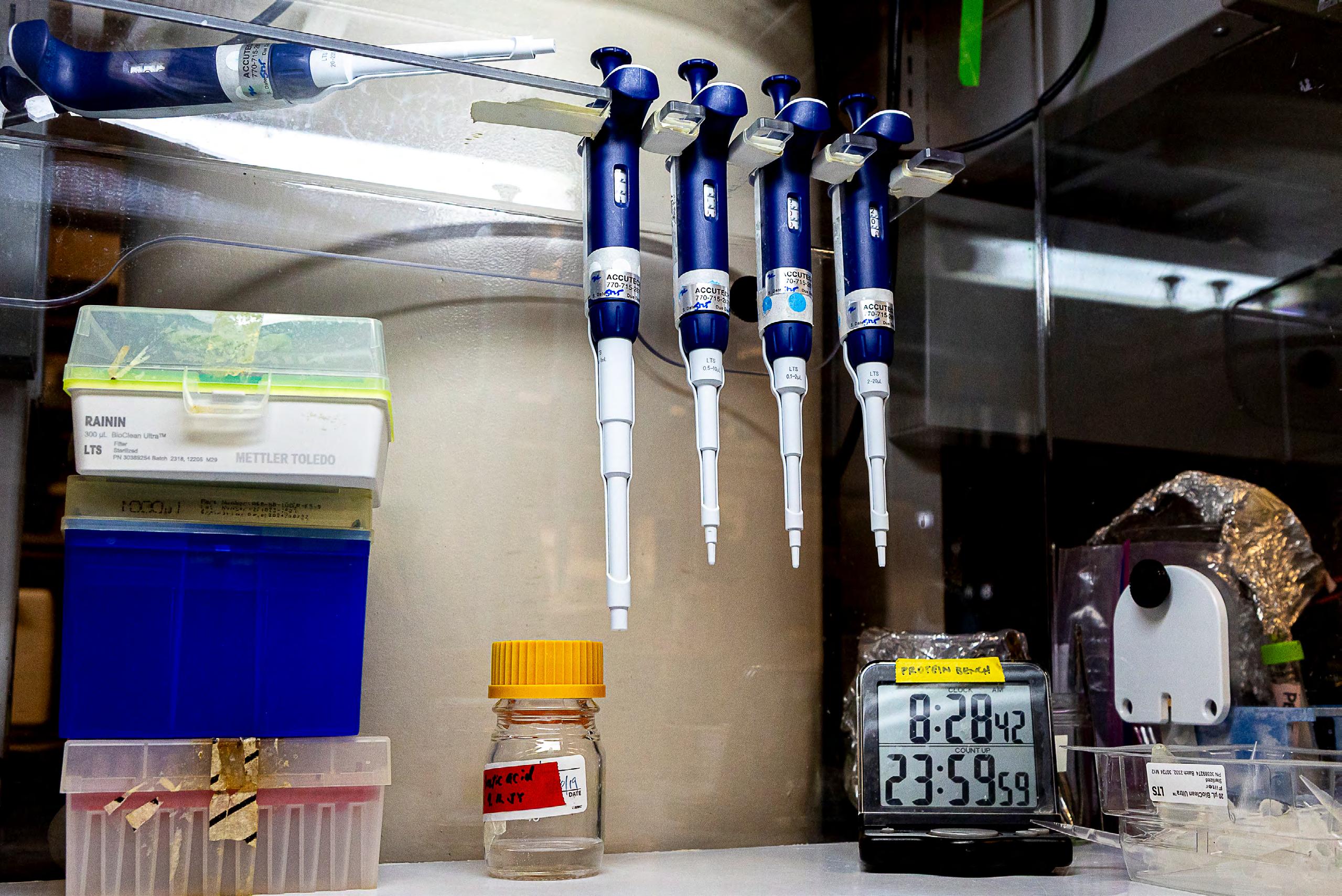

The Red Zone refers to the period between move-in week and Thanksgiving break on college campuses when more than half of sexual assault occurs.
Editor’s note: This story contains mentions of sexual assault and violence, which some readers may find disturbing.
When she first moved into her Honors dorm in 2022, a senior studying visual communication, who wishes to remain anonymous for her personal safety, said she was excited for the college experience. She decorated her room, made friends and drank alcohol for the first time.
Within weeks, her excitement faded. A male student she met on Tinder assaulted her in his dorm room while she was incapacitated. She said she did not tell anyone what happened and continued to date him for nearly a year.
“Every time we had sex after that, it just felt like something I was forced to do,” she said.
Her experience echoes that of many college students who are navigating new environments and academic demands. Freshmen, who are often away from home for the first time, are more likely to engage in reckless behavior such as excessive drinking, smoking and drug use while adjusting to a newfound lack of parental oversight.
This initial period of adjustment between movein week and Thanksgiving break is known as the Red Zone, when more than half of sexual assaults occur on college campuses.
Elyce Morris, NAU’s Title IX coordinator, said first-year students face a heightened risk of sexual violence during the Red Zone while they adjust to the university setting.
“Anyone navigating new social settings and friend groups could be at risk,” Morris said.
According to information from the Rape, Abuse & Incest National Network (RAINN) last updated in August 2025, roughly 26% of undergraduate women and 7% of undergraduate men report experiencing nonconsensual sexual contact by physical force
or incapacitation during their time in college. Nearly 42% of all students reported experiencing at least one sexually harassing behavior since enrollment.
Additionally, studies from RAINN show female students ages 18-24 are three times more likely to experience sexual violence than women in the general population.
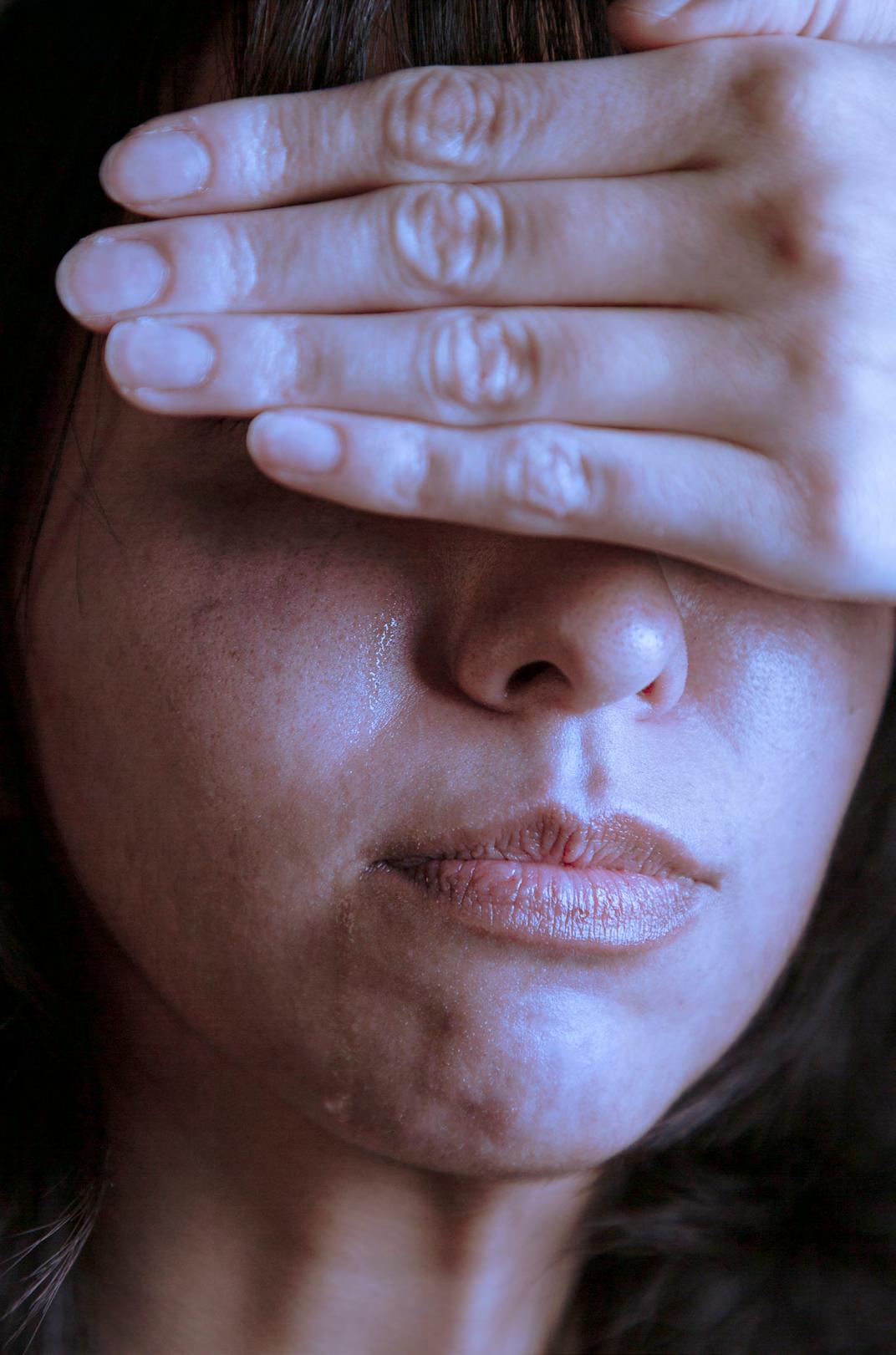
LGBTQ+ students, students of color, students with disabilities and other marginalized groups also face increased danger of sexual violence during the Red Zone due to discrimination, bias and responses that minimize their experiences.
“Freshman year is such a different living situation,” the student said. “You have a roommate you’ve never met before, you’re away from home and no one is there to stop you from making unsafe choices. I had never drunk before college. I didn’t even know how alcohol worked.”
NAU documented 17 confirmed cases of rape on campus last year. This is nine fewer than in 2020, when the university reported more cases than both UArizona and ASU despite having a smaller student population.
Morris said NAU’s Title IX team uses reporting trends to guide prevention efforts and target education. However, many survivors of sexual violence do not report their assault out of fear or shame.
The student said she did not realize what had happened to her was assault, and did not report her assault out of fear and confusion over what happened.
“I didn’t tell anybody about that first time for a year,” the student said. “Holding that in affected me. It will affect me for the rest of my life. I did tell somebody, but she basically blamed me and told me it was my fault.”
Her story is not unique; the U.S. Department of Justice reports that 85% to 90% of sexual assaults reported by female college students are perpetrated by someone known to the victim, and roughly half occur on a date. The most common locations are the man’s or the woman’s home.
Not talking about it doesn’t make it go away, It stops happening when we start talking about it, and when we normalize people talking about their experiences.
— Anonymous student
To address these risks, NAU has incorporated programs like required sexual assault prevention training for all students and faculty, the NAU Safe app, NAUPD’s safe walk program and campus health services like STD and HIV testing. Additionally, Campus Living hosted “Rock Out the Red Zone” on Sept. 4 to educate students on sexual violence and the Red Zone.
Katrina Mikitik, a coordinator and forensic nurse at Northern Arizona Care and Services After Assault (NACASA), said early education about consent and available resources can make a difference to survivors looking for help.
NACASA provides services to patients who have experienced sexual assault, intimate partner violence and strangulation. This includes medical forensic exams, STI prevention medication, emergency contraception and referrals to counseling or advocacy services.
“It is our primary goal to make sure that a patient who comes to us at what is sometimes the most vulnerable and worst time of their lives, that we can restore autonomy over their body, autonomy over decision making,” Mikitik said. “We can give them an opportunity to tell us what they need and what they want and empower them to begin that process of healing and moving forward from this assault.”
The Violence Against Women Act, passed by Congress in 1994, states anyone who has experienced sexual assault or believes they may have experienced sexual assault has the right to a sexual assault medical forensic exam (SAFE).
During the exam, forensic nurses can provide treatment, physical exams and emergency contraceptives or connect patients with mental health services in a one-on-one


or been made aware of NAU’s resources, her assault may not have happened.
“I was just like, ‘Oh, I’m at college. I should be going on Tinder dates with people. I should be hanging out with men,’” she said. “If I had thought that wasn’t what I had to do, my life would be very, very, very different.”
setting. SAFE exams should be completed within five days of an assault.
Although nurses collect and store medical evidence during the exam for potential later use, it is not necessary to report assault in order to receive a SAFE exam.
“Sometimes, the first step isn’t about reporting,” Mikitik said. “It’s about safety and understanding your options.”
To open dialogue and increase awareness around sexual violence, Morris said collaboration is essential between the university’s departments, law enforcement and community organizations like NACASA and Coconino County Victim Witness Services
The student said if she had known about the Red Zone
Morris said clear boundaries and strong support systems can help reduce the risk of sexual violence. She encouraged individuals to respect their partner’s wishes and seek clarification about consent if there is ambiguity during sexual interactions. Additionally, Mikitik said bystander intervention training allows people to step in and speak up when they witness assault.
Talking about assault after it happens can also help break stigmas around sexual violence and encourage survivors to report nonconsensual contact.
“Not talking about it doesn’t make it go away,” the student said. “It stops happening when we start talking about it, and when we normalize people talking about their experiences.”
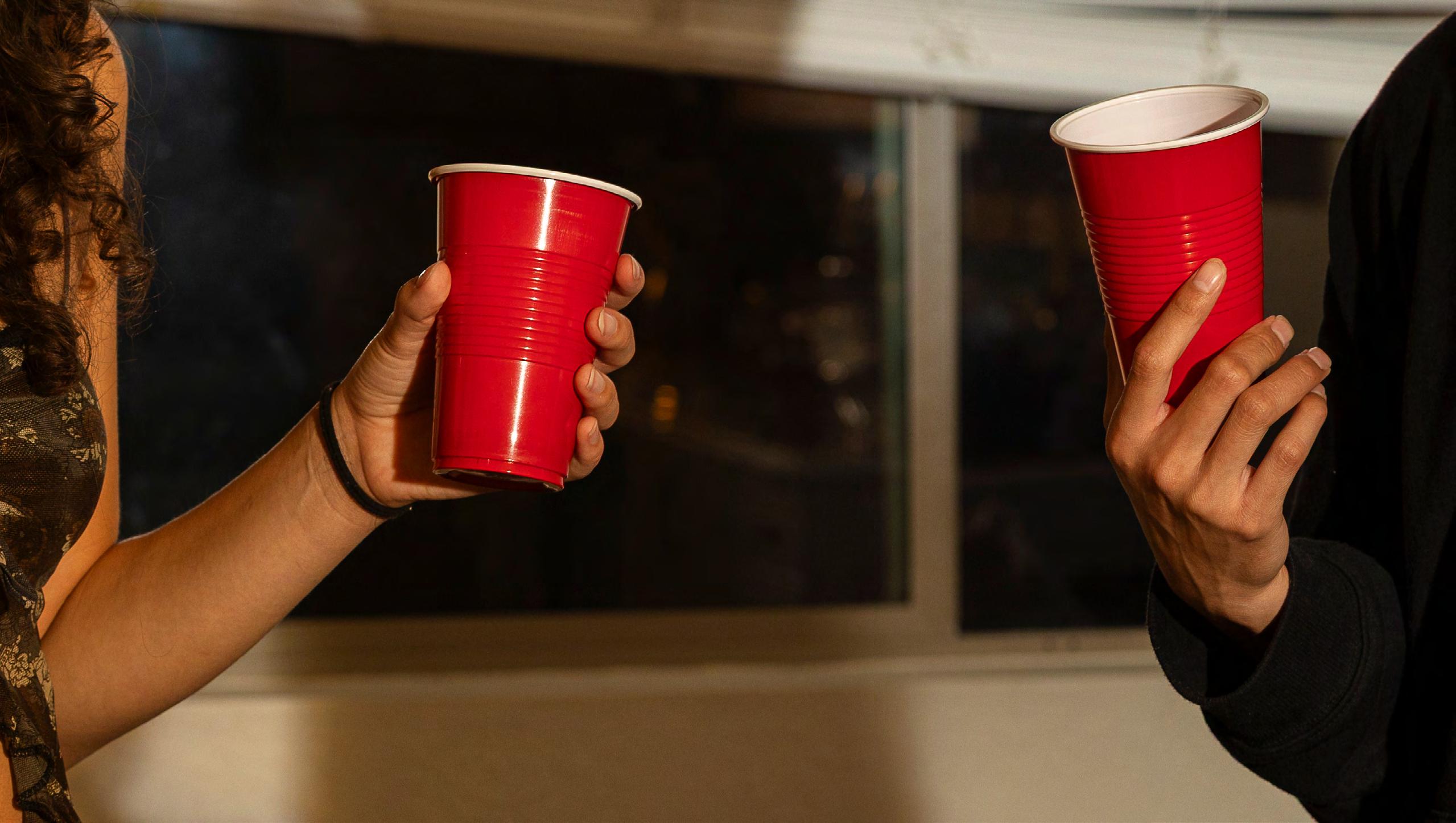
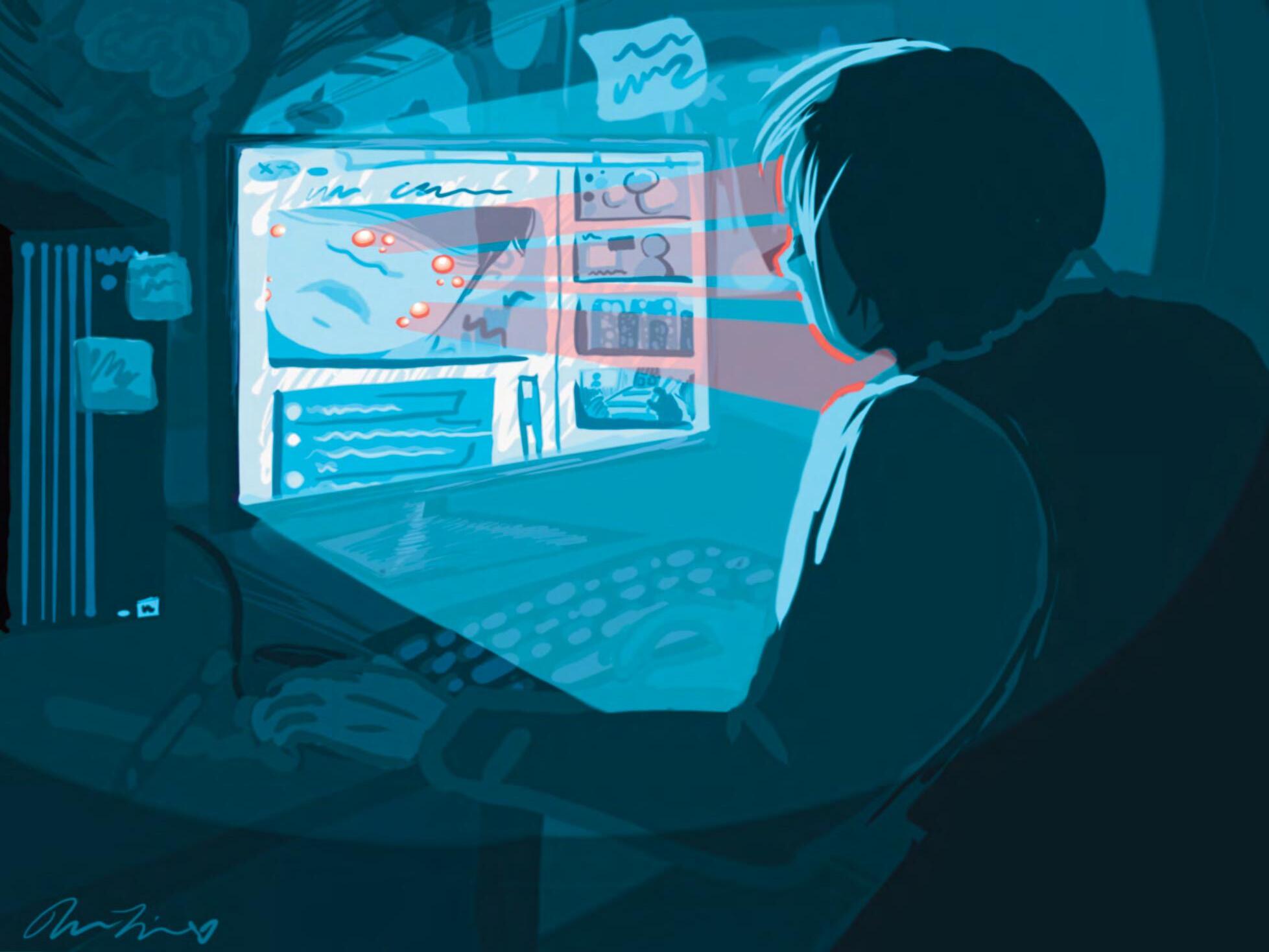
Story by Katie Tsoukatos Illustration by Rosela Limas
After a long day, Abigail Walker likes to lie down in bed, open her phone and watch videos of swollen pimples being squeezed until they burst into mountains of pus. While many people might find pimplepopping videos nauseating, Walker considers them comforting.
“I find that they cause all the stress and worries to melt away,” Walker said. “There’s something very therapeutic and cathartic in being able to rest and watch these kinds of videos.”
The internet offers instant exposure to an endless stream of content, from gory injuries to blackhead extractions. With so many videos available, why do viewers like Walker still
seek out the objectively disgusting?
The answer can be found by studying disgust, a basic human emotion closely tied to survival.
Robert Goodman, an associate professor of psychology at NAU, said disgust is more than just a feeling of discomfort.
“Disgust can be thought of as a psychological extension of our immune system,” Goodman said. “It’s an emotion that leads people to avoid potential sources of contamination and disease.”
The idea of disgust as a protective instinct is far from new. English naturalist Charles Darwin was among the first to document the emotion as innate and involuntary in his 1872
work “The Expression of the Emotions in Man and Animals.”
Darwin considered disgust an evolutionarily ingrained response that helped early humans avoid life-threatening hazards like rotten food and bodily fluids. He wrote humans who were easily disgusted were better equipped to avoid danger and survive long enough to pass on their traits.
University of Toronto psychology professor Yoel Inbar said the emotion can be thought of as a “distancing response.”
“The negative feeling we get after being exposed to something disgusting motivates us to move away from that thing or avoid contacting it,” Inbar said. “It’s really helpful
for our long-term survival.”
If disgust is thought to prevent people from engaging with gross objects, why do so many willingly seek them out?
While there are no definitive answers, many scientists attribute this phenomenon to benign masochism, a term coined by psychologist Paul Rozin to describe the enjoyment of seemingly negative experiences.
Rozin’s theory states that small, controlled doses of discomfort allow people to interact with pain and fear without the presence of an immediate physical threat. This degree of separation is what enables people to find enjoyment in traditionally unpleasant visuals.
Inbar said people might be drawn to disgusting content because they can engage with it without facing real consequences.
“We’ll watch a scary movie, but we wouldn’t actually want somebody to chase us with a knife,” Inbar said. “We’ll watch a gross video, but we wouldn’t want to be submerged in something like rotten meat. These things are positive because they’re limited. They let us experiment and play with negative sensations, but in a way we feel control over.”
By using screens as protective barriers, viewers can interact with unsettling content safely and perceive even the goriest sights as more approachable.
Walker said she loves to watch slasher films and gory movies, but would not want to witness her favorite scenes in real life.


“I find these kinds of things interesting, but would much rather see them behind a screen because there isn’t a possibility of getting hurt in the process,” Walker said.
A 2024 study conducted by University of Pécs researchers found that disgusting content in horror movies lowers viewer enjoyment, but does not reduce excitement. These findings suggest people can remain excited and psychologically engaged with content they find unpleasant.
Goodman said gross content might be enthralling to some viewers because it elicits a sense of physiological arousal, which the brain can reinterpret as excitement.
Viewing bizarre content is not always about thrill-seeking or excitement, as it can simply be a way to escape boredom.
Inbar said some people would rather experience the wide range of emotions triggered by negative stimuli, including fear and discomfort, than be bored.
This idea is supported by a 2014 study conducted by social psychologist Timothy Wilson. Participants were asked to take part in 15-minute “thinking periods” while alone in a room, with the option to shock themselves if they wanted to. Wilson found many participants chose to administer themselves the electric shock in the absence of external stimuli.
Wilson’s study reveals how uncomfortable being alone with one’s thoughts can be and
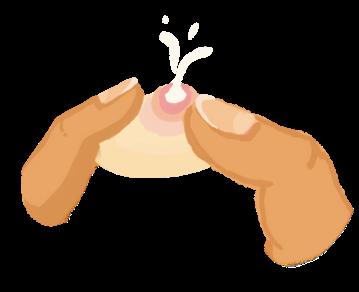
the lengths people will go to escape them.
Walker said gross videos provide mental stimulation without demanding her full attention.
“They’re easy to get caught up in, especially when you’re bored, because you don’t have to put a lot of thought into watching them,” Walker said.
In safe, controlled environments, engaging with disgust can fulfill the human need for stimulation and physiological arousal. Beyond shaping what people watch, disgust can also influence thoughts and decision-making processes.
Goodman said exposure to unsettling content can reduce prejudice and implicit biases in viewers by forcing them to confront uncomfortable realities and their internal assumptions.
“If you’re the kind of person who loves grossing yourself out, then you have a lower disgust sensitivity,” Goodman said. “The less sensitive you are to disgust, the less it’s going to influence your moral and social decisions.”
Disgust was once humankind’s key to preservation. Today, the very emotion that has kept people from harm might expand what is considered socially acceptable and allow the human mind to take pleasure in what it most needs protection from.

Story by Elliott Stringer
Illustrations by Haleigh Williams
Photos by Elliott Stringer, Sarah Manning, Tegan Kelley, JL Arnold III
Aspen trees are clonal organisms.
Connected by an extensive underground root system, they communicate with one another and send warnings if something bad is happening to another tree.
When someone cuts into one tree’s thin bark, they permanently damage and expose its circulatory system, increasing the probability of infection. If one tree is infected, the likelihood of the infection spreading is high, leading to entire aspen colonies falling sick with no chance of recovery.
Julia Totty, a second-year master’s student studying forestry, said many things harm the aspens outside of the carvings, including climate change, insects and fungus.
Invasive insects and fungi are the primary causes of infections once

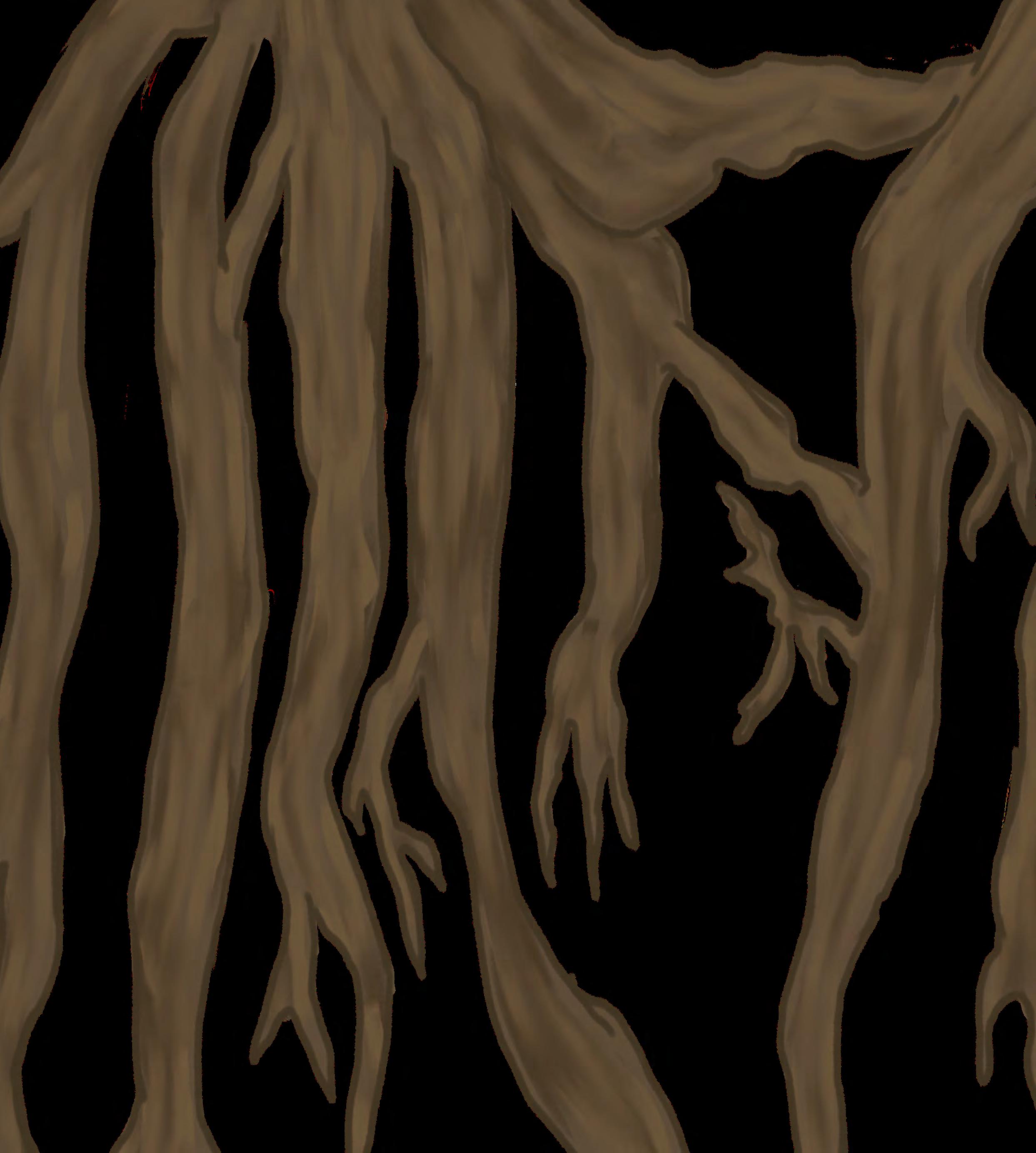
the trees have been cut open. Totty said aspen trees at lower elevations are in more danger overall, not only because they thrive at higher elevations, but because the hotter temperatures contribute to infection.
She compared the process to people becoming prone to infection after an injury. Once aspens are cut open and carved into, there is little one can do to cure them.
“Flagstaff is kind of the southwesternmost range, or the edge of the range, for healthy aspen trees,” Totty said. “Everything that we’re seeing at the base of the mountain is already heat-stressed, and that’s why I study a specific insect that’s invasive here, attacking the aspen trees. It prefers the aspen at a lower elevation that already has heat stress.”
Totty said there are many carvings on Flagstaff’s trees, especially in places tourists visit often, such as Snowbowl, Kachina Trail and Aspen Corner. She said if people see the carvings and know nothing about trees, they might be inspired to leave their own since other people previously have.
The only time Totty said she can sympathize with those who carve into trees is when they scratch out hate symbols or offensive imagery, like genitalia or slurs.
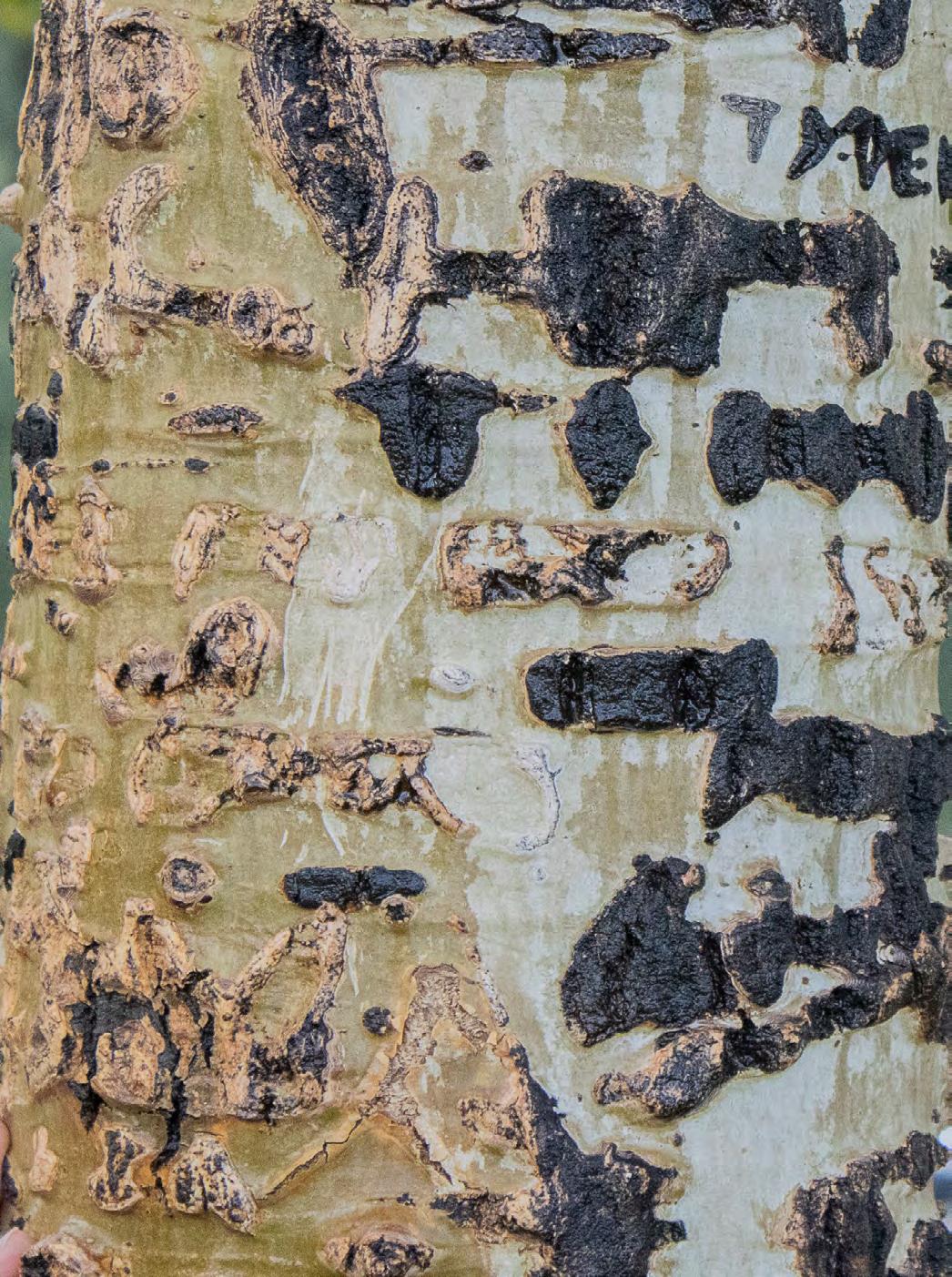
“A lot of the carvings that I see in the trees right now are a lot of initials and hearts, but I also see a lot of hate symbols carved into trees,
which is horrifying,” Totty said. “I was doing a lot of work on [Kachina Trail] in 2022, and there were a lot of Nazi symbols out there, and this is really not cool. I think that doesn’t ever need to be represented. You can’t ignore something like that.”
Preserving the forest, keeping it healthy and leaving no trace are important to Totty. She said that with more people carving, it is becoming harder to ignore the practice’s impact on the forest.
Holly Maszk, the preventative search and rescue volunteer coordinator for the Coconino National Forest Service in the Flagstaff Ranger District, has worked on Humphreys Peak Trail for the past three years. Maszk said she enjoys being out in nature while working directly on the trails to protect them alongside the trees.
As the temperature increases due to climate change, the living conditions of the aspens change as well, with multiple factors threatening their well-being.
Snowbowl is one such threat. In December 2024, Snowbowl plowed through Aspen Grove to construct a new ski lift and hiking trail. The lift was part of Snowbowl’s expansion, which faced pushback from the Havasupai, Hopi and Navajo Nations. Over a dozen Indigenous nations consider the San Francisco Peaks sacred, leading to decades of lawsuits and controversies surrounding Snowbowl’s desecration of the land through construction and reclaimed water use.
Because the trail is new, Maszk said she expects the trees to remain


unmarked until the end of October, when tourists travel to watch the leaves change. She said the trees in the grove are unmarked because they were not on the trail before, leaving them inaccessible to tourists and hikers.
“A lot of these trees in here, some of them are kind of carved because they were still accessible, but the other ones are still pristine,” Maszk said. “We’re putting up these signs to hopefully get people not to carve them all by the end of October.”
The Coconino National Forest Service recently installed signs along trailheads in hopes of educating people about why carvings are harmful to trees. Maszk said this is all they can do to try to protect the aspens.
There are only two law enforcement officers for all of Coconino’s forest, which extends down to Sedona. Maszk said it is hard to control people’s actions, and they should focus more on education than enforcement.
“We can’t do anything,” Maszk said. “When we see people carving into the tree, we let them know, we educate them, but there’s nothing else we can do. We can’t write them a ticket. We can’t fine them. The forests are so huge.”
Emmie Vander Pluym, a first year master’s student in NAU’s forestry program, said while her field was previously always looking for workers, finding a job has been near impossible since the Trump administration’s layoffs. Vander Pluym said there are many overqualified people who end up in entry level positions meant for graduate students. She said people
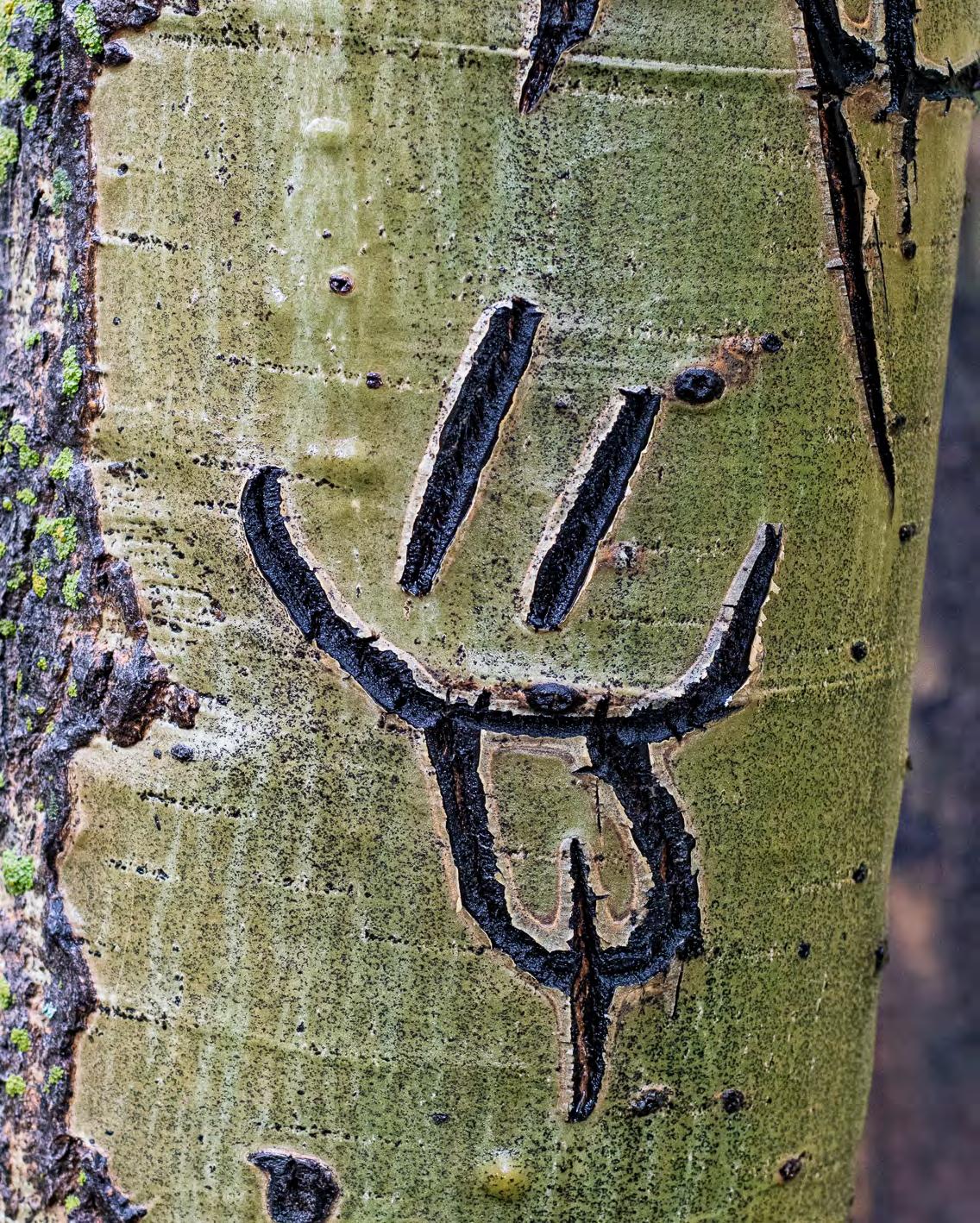
who already have their master’s degrees are typically hired because they already have the experience.
With funding cuts, Vander Pluym said not only has studying been hard, finding internships and support has been difficult and taken a toll on her mental health.
“I had funding for my master’s, and then I got DOGEed,” Vander Pluym said, referring to the Department of Government Efficiency (DOGE). “Apparently, ants and fungus are woke and they had to take away my funding. Is it woke to like trees?”
Many layoffs are closely related to climate science, forestry and national parks.
President Donald Trump referred to climate change as a “con job” at a United Nations General Assembly after months of DOGE-led cuts to climate agencies and research funding. The Trump administration referred to these canceled higher education grants as “woke spending” and specifically targeted environmental justicerelated programs.
Vander Pluym said “Leave No Trace” becomes especially important when it comes to nature. Not only should people avoid carving into aspen trees, but they should also check and clean their shoes, so as to not track any elements from foreign environments into the forests, and to not litter or feed animals.
Sarah Manning
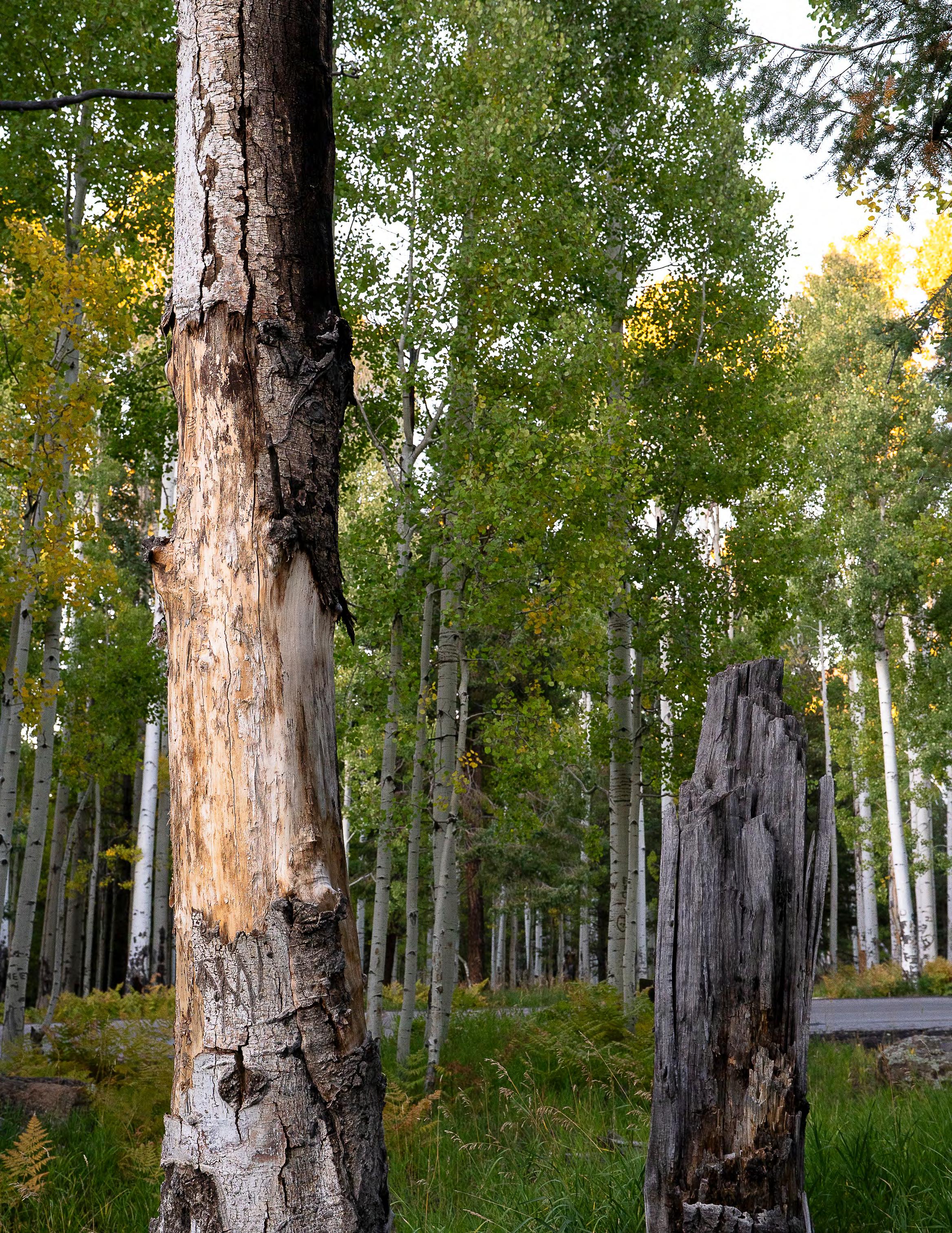
They might not realize the effect that they’re having on the tree. Maybe just always keep in mind, leave no trace, even if you’re in an urban setting. It still matters.
— Emmie Vander Pluym
People may want to permanently show their love for one another through these carvings, and Vander Pluym said she understands this, however, the lack of education the public has, not only about these carvings but nature as a whole, is disappointing.
“Aspen are really special, and I’m sure everyone who sees them and wants to carve a heart with initials in it, I’m sure they are doing it because they think the tree is beautiful,” Vander Pluym said. “But they might not realize the effect that they’re having on the tree. Maybe just always keep in mind, leave no trace, even if you’re in an urban setting. It still matters.”
Some tribes, such as the Apache Tribe, used the thin layer of white bark cells that come off when you rub the trees as a form of sunscreen, Maszk said, while others used the bark and roots to treat medical conditions such as head or stomach aches.
“Aspen are incredibly culturally significant, whether that be to Indigenous people or the people of Flagstaff,” Vander Pluym said. “They’re significant all over the world. I feel like they’re a very charismatic organism, in a sense, you think of the beautiful leaves changing.”
Since the trees are also living creatures, Vander Pluym said, people should be treating the aspens with the same respect as they would show other humans.
Maszk said the stress the aspens receive from carvings, climate change and wildfires takes a toll on their health, leading to faster decline and rotting.
“They don’t need more stress,” Maszk said. “They are already in decline, they don’t need humans too.”
Maszk said if people want beauty to enjoy in the forest, they need to make it last because once it is gone, there is no reviving it.

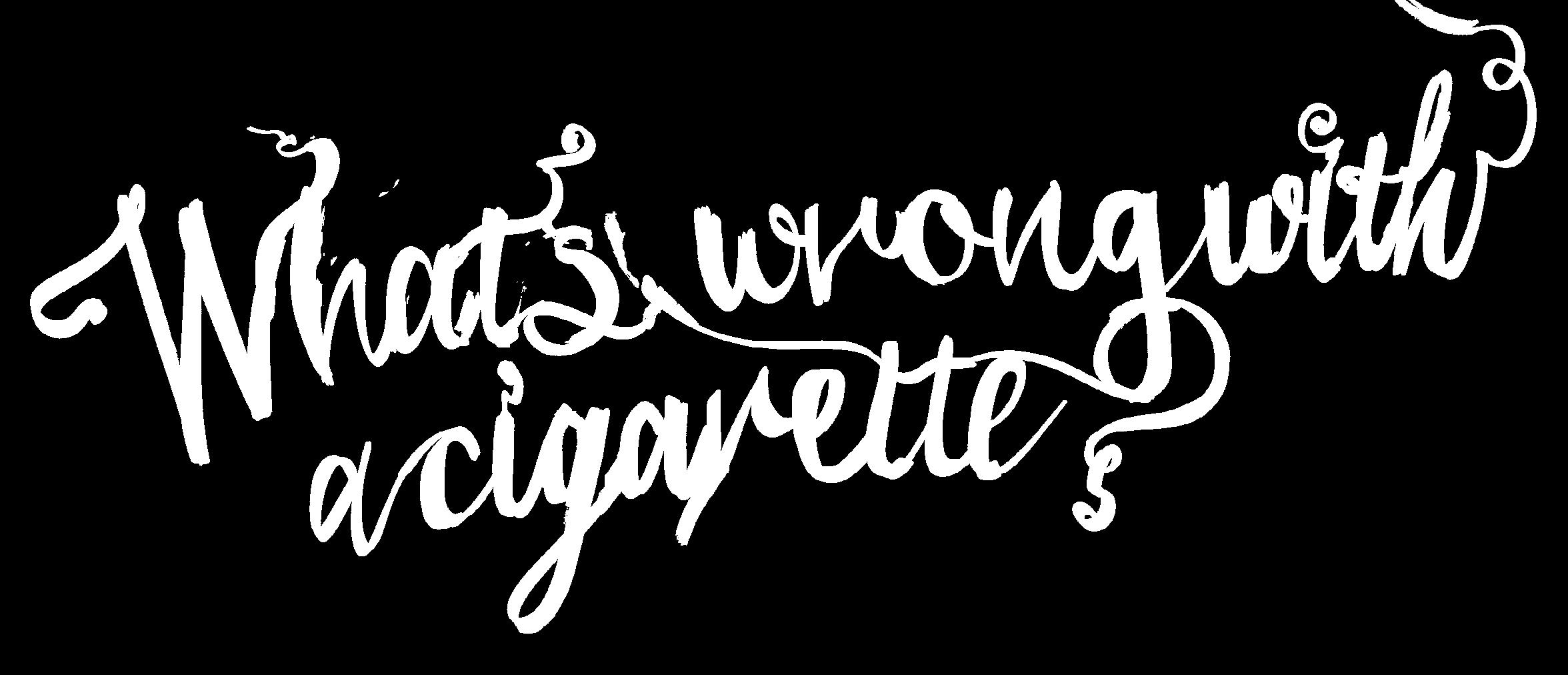
In the U.S., college culture promotes reckless behavior; late-night partying, binge drinking and substance use among young adults are deemed normal. During this period of new freedoms, even normal experiences, from job hunting to apartment shopping, can feel stressful and isolating.
Walking around a concert venue, the music is loud and people inside are drinking. Carlos Bravo makes a turn for the door to a smoking patio, where the music is muffled, and pulls out a cigarette. He’s asked for a light in exchange for a conversation.
Bravo, a photography major at NAU, started vaping at age 15, but switched to smoking multiple cigarettes a day after beginning his college career.
That’s called a gateway effect, place when someone who has never smoked starts vaping and later transitions to cigarettes.
Bravo said smoking cigarettes alone came after he smoked socially for a while.
“From there, I started college, so I was around its influence a lot more,” Bravo said.
“I decided, ‘F— it, give me a few cigarettes.’”
A 2012 study
Psychological Association found that college students often smoke while drinking in social settings like concerts, parties or festivals.
For college students, smoking cigarettes allows for easier access to social environments and provides a common interest to bond over.
According to the 2023 Surgeon General’s Advisory, social isolation and loneliness have equal to or greater effects on young adults than substance abuse and is just as damaging to mortality rates as smoking 15 cigarettes a day.
Bravo said the Flagstaff music scene gives him a community to avoid isolation, but he continues to smoke.
“Everyone smokes cigarettes,” Bravo said.
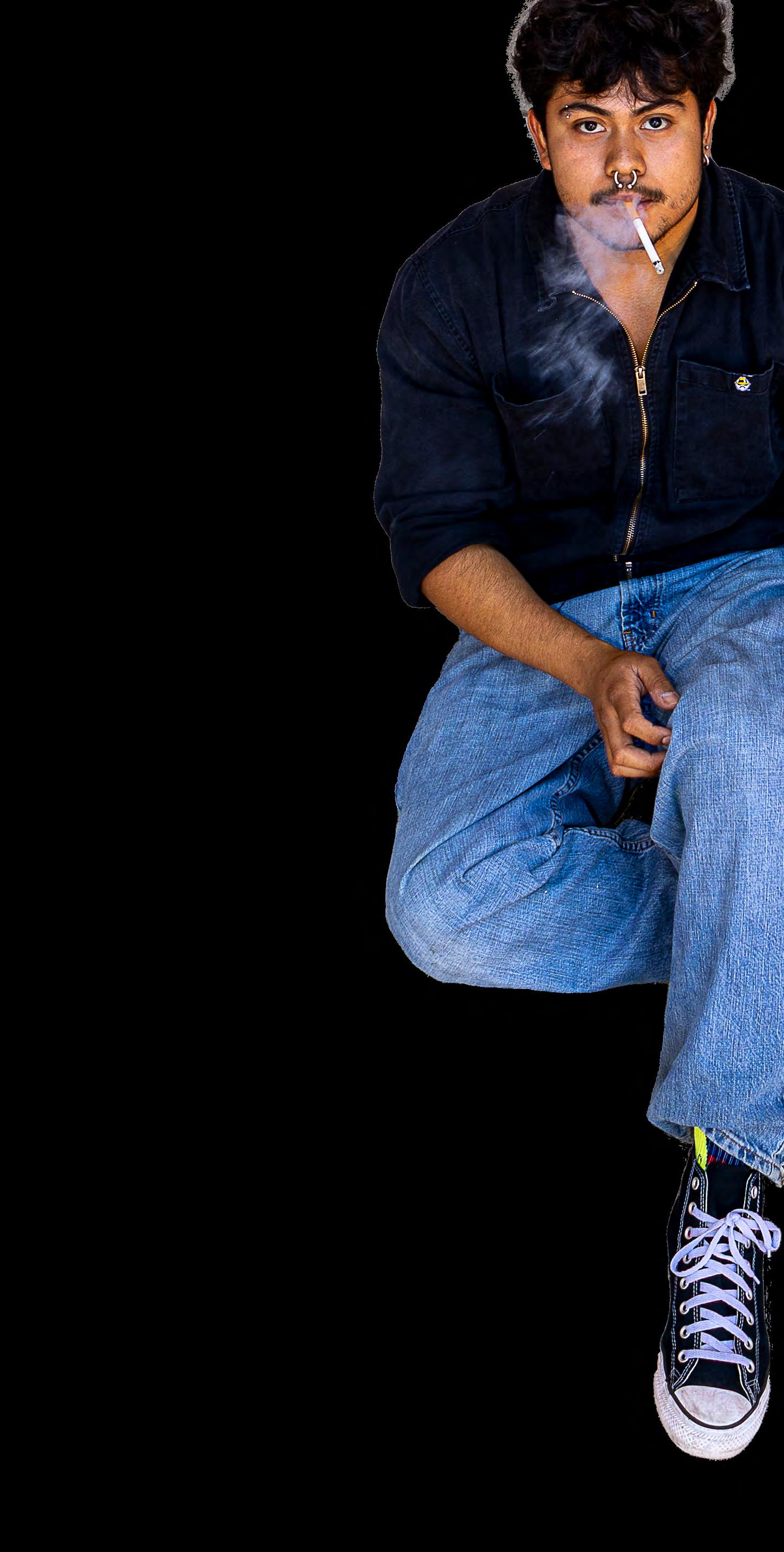


From there, I started college, so I was around its influence a lot more. I decided, ‘F— it, give me a few
Carlos Bravo

cause stress as a result of constant access to a wide array of social content. This can lead to fear of missing out and anxiety for approval
“Social media impacts me in two ways,” Gallagher said. “One is exposure. Two, ‘everything is on fire,’ but I feel like I’ve noticed the cigarette as a desired aesthetic risk for young people, especially women, to develop published a study that found nicotine is an appetite suppressant and alters eating patterns, often resulting in published by found that groups already at risk for disordered eating use smoking as a tool for in the worlds of heroin chic” look, a fashion trend from the ‘90s that glorified models with an emaciated body, has
Cigarette Daydreams” by Marlboro Nights” by Lonely God transport listeners into a heightened mood while enjoying a smoke. emphasizes passionate imagery with black and white
As the sun sets on a long day, Chiaravalloti is not immune. She drives home from work and rolls down the sunroof of her car, blasting music and sitting with a cigarette in hand. She inhales the smoke that flows through her, it tightens her chest and leaves a slight sting.
When she exhales, Chiaravalloti forms her mouth into an “O” shape to puff rings of smoke out of her mouth. Her muscles relax and the
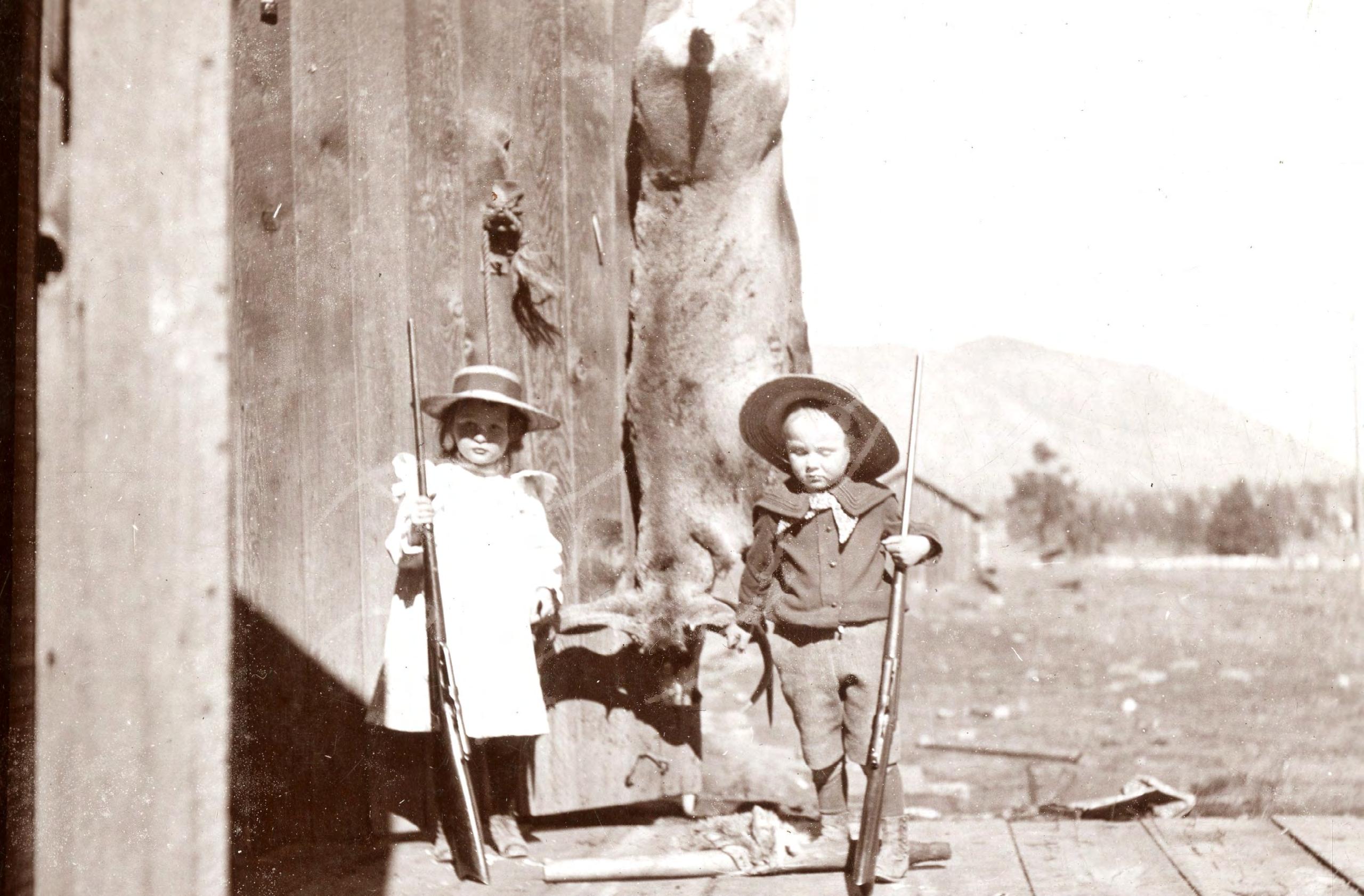

Awhiff of warm air tells me I must have startled a skunk on my way up the Riordan Mansion’s back porch steps.
The halls are silent — creaky floorboards notwithstanding — and still as I wander through with Nikki Lober, the park manager and my guide in white museum gloves.
Its docents describe it as the best duplex in Flagstaff; Timothy and Michael Riordan designed their 13,000-square-foot home as two symmetrical houses connected by a central rendezvous room.
The inside is dimmer than one might expect for a little past 3 p.m. In 1904, the electric bulbs were thoroughly modern; now, they have a distinct 20th-century glow about them. The light doesn’t reach the corners, nor the basement crawlspace, which Lober reveals behind a bolted wood door.
Jaina Domkus is a senior studying history and a former intern at the Riordan Mansion State Historic Park. She prepped me for this tour with a summary of her research on the Riordans’ extensive collection of
4,000 books and magazines.
“Flagstaff really just would not be the town it is if they didn’t exist,” Domkus said. “Trying to build the community, that’s such an important part of who they were, what they did for us and why we care about them nowadays.”
Karen Washabau, who gave tours at the Riordan Mansion for nearly 10 years, corroborated.
“Everywhere you go in this town, if you know a little bit about the Riordans, you can point to something they had a hand in,” Washabau said.
They’re all telling me the Riordans — along with a handful of other impactful families — built this town. In some ways, it’s true; the family aided in the construction of two churches, the first public and private schools, a public library, the university, Lowell Observatory and the dam at Lake Mary
By this point, I am intimately familiar with the Riordan brothers. Through archival research, I’ve seen their children’s baby photos and learned to decipher their tangled scrawl.
I’m reconciling this home — spotless, but staged to mimic its past vibrancy — with the history I know to be more complicated. Beyond who lived in the mansion, I wonder who built it, who staffed it and whose land was stolen to put it here.

“Ahora no más los recuerdos nos quedan,” [Now all we have left are the memories] Procora Vergara Martinez said
She sat down for an interview in fall 2002, part of Delia Ceballos Muñoz’s “Los Recuerdos del Barrio” oral history series with early Flagstaff community members.
Martinez grew up in Topia, Durango, in northwestern Mexico and immigrated to Flagstaff around 1925. Her family lived and worked at the Arizona Lumber and Timber Company logging camp, where she was a cook.
A local historian has dedicated his research to preserving and uplifting under-documented perspectives on Flagstaff’s history, namely those of his own Mexicano community. His familial roots in northern Arizona go back over 100 years. The Lumberjack granted him anonymity to protect his employment.
“We’ve had generations now where our narrative has been eradicated, erased, rewritten, trampled on,” he said. “I believe now it’s up to the descendants of those people to right the narrative.”

“At the risk of being considered premature I would beg to submit to the Honorable Commissioner some of my observations while at the Agency,” Denis Matthew Riordan wrote in an 1882 letter. “In the first place I found the agent’s quarters filthy in the extreme.”
Denis Matthew, who went by Matt, arrived at the Fort Defiance Indian Boarding School, northeast of Flagstaff, in December of that year. He complained to a superior that his accommodations were dirty and dreary, vermin-infested — wholly unsuited to his civilizing mission.
Matt followed up after 13 days: “Filth and slovenliness characterize everything I have yet seen.”
“If the Indians get their ideas of cleanliness and order from the present condition of this school my judgment is they will retrograde,” Matt said.
He concluded on an optimistic note: “I do not doubt that it can all be remedied.”
Matt was steadfast in his belief that Indigenous Southwesterners could be groomed to resemble “the ordinary white person” through industrial labor.
It was with this task in mind that the first Riordan wandered out West. Matt was agent to the Navajo for only a year and described it as the hardest he had ever worked.
Just months prior, in August 1882, Edward Ayer completed construction on the Ayer Sawmill in Flagstaff. Ayer began a contract to supply wood for the Santa Fe Railway line’s westward expansion; Matt’s nephew Richard White recounts before the railway, his uncle traveled to Arizona from Chicago on horseback.
By 1884, Matt moved to Flagstaff to manage the sawmill, and by 1887, he assumed ownership of the Ayer Lumber Company, which soon became the Arizona Lumber and Timber Company (AL&T Co.).
Matt’s younger brothers, Timothy and Michael Riordan — Tim and Mike, as everyone called them — arrived around 1885. Matt officially sold the AL&T Co. to the pair in 1893.
Tim and Mike settled in Flagstaff, marrying a pair of sisters, Caroline and Elizabeth Metz, in 1889 and 1892.

Back at Fort Defiance, on Aug. 13, 1883, Matt wrote another letter This time, it was to Richard Henry Pratt, founder and superintendent of Carlisle Indian Industrial School. Pratt originated the initiative to forcibly assimilate Indigenous Americans, beginning with a group of prisoners of war in 1875.
Matt worked closely with Pratt and the Carlisle Indian Industrial School, aiming to replicate its model at Fort Defiance. In the letter, Matt addresses the death of a student named Manuelito Chou.
“The loss of two of the party has the usual effect on unreasoning and ignorant minds,” he wrote.
Manuelito, a Navajo chief, lost two sons and a nephew to an outbreak of tuberculosis at the Carlisle Indian Industrial School.
The letter continues, describing the tribe leaders’ reactions to the death as irrationally violent. Matt writes, even if he or Pratt is killed in retribution, the project must go on.
The Riordan Mansion was built by brothers Timothy and Michael Riordan. The brothers owned the Arizona Lumber & Timber Co. and began the build of their home in 1904. Grace Herzig
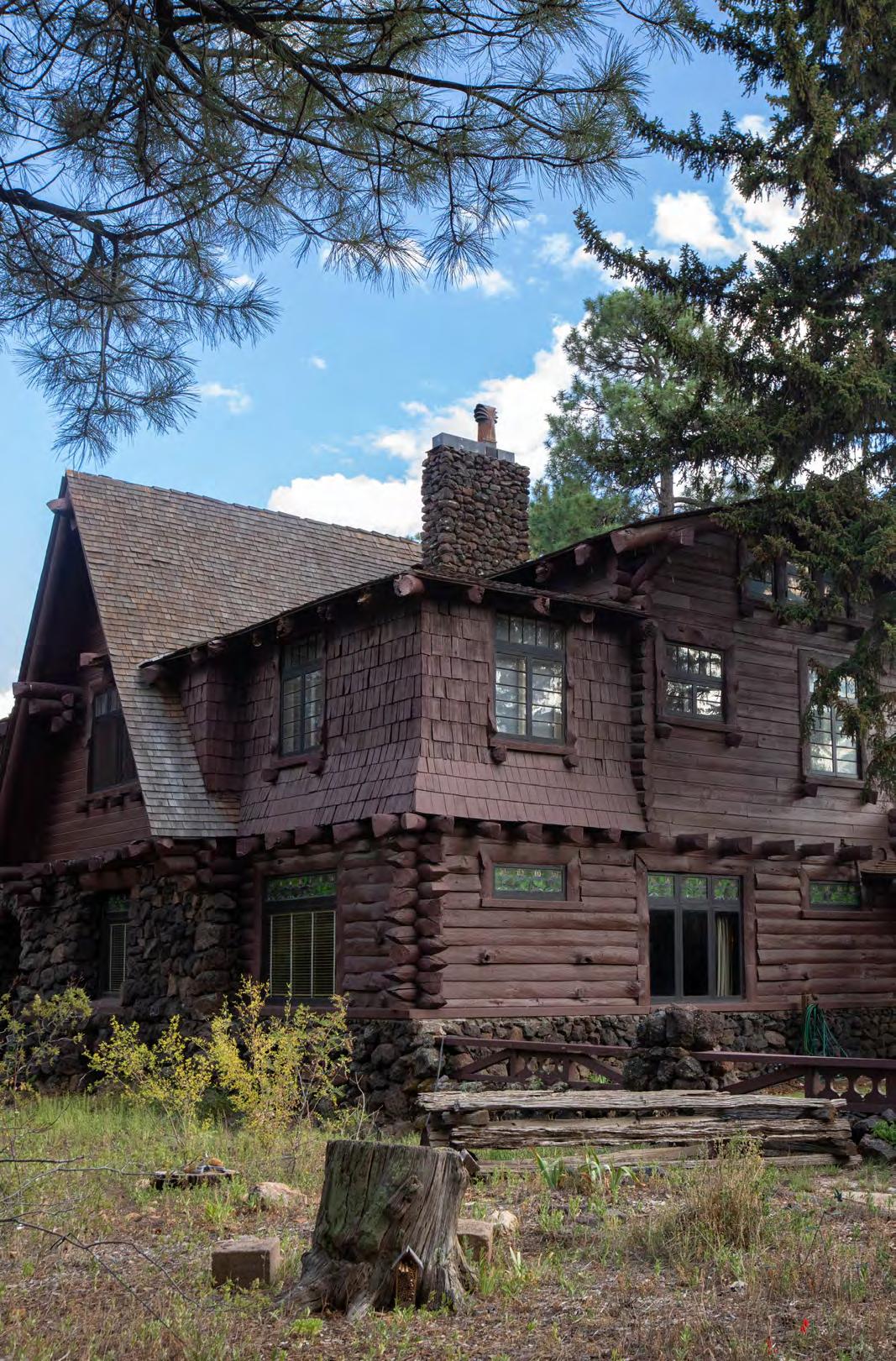


Mike, suffering from tuberculosis himself, embraced and was embraced by Flagstaff’s dry, pine-scented air. In what his family describes as something of a miracle, he lived for 45 more years.
In that time, he served on the founding board of Flagstaff’s Catholic Church.
Martinez said the AL&T Co. took a mandatory fee from employee paychecks, including hers and her husband’s, to finance the reconstruction of the Nativity of the Blessed Virgin Mary Church downtown.
“De repente los hombres ayudaban hacer ese edificio, pero los que no ayudaban, que trabajaban, les quitaban del cheque que, que ganaban. Sería un peso o dos,” [“Sometimes, some of the men helped to build that building, but for those who did not help, those that had to work, they took from their paycheck, that they earned. It would be a peso or two.”] Martinez said.
The work wasn’t easy.
“It was brutal,” the historian said. “It was incredibly hard. It was something that we can’t quite comprehend.”
Growing up, he said, it was normal to see ex-loggers with missing fingers. He knows of at least one case where a workplace injury — and lack of adequate medical care — resulted in the death of a Mexicano employee.
Despite physically laboring and financially contributing to the church’s construction, upon its completion, workers of color were prohibited from worshipping there.
“We helped build it, we helped pay for it, but then once it was built, we weren’t allowed to worship, and to be Catholic, within that church because they didn’t want no ‘dirty Mexicans’ in there,” the local historian said. “That’s the language that was used.”
The written record of the church’s history — authored by Mike himself — recalls its development, but not its de facto segregation.

The sun, as it starts to wane in the west, paints brilliant streaks across the Riordans’ deep red carpet.
Given the sensitive nature of these histories, I went back to the Riordan Mansion for comment. I asked how they might make space for underrepresented narratives and move toward a fuller, more nuanced understanding of Flagstaff history.
On behalf of the Riordan Mansion State Historic Park, Lober wrote the following statement, which The Lumberjack has edited to follow Associated Press guidelines:
“I would like to preface my comment with that I have not been given the opportunity to read the article or see the original source material mentioned. As public historians, it is our responsibility to include multiple perspectives as we interpret history to the public. We utilize a variety of resources to gather facts and perspectives with primary sources being the most accurate.
“Conversations (oral histories) with descendants are valuable to discover new stories and the perspectives that have been passed down. These are great starting points to dig deeper and find primary sources to support the story. Once a new piece of information has been thoroughly researched and verified, the information is added to our research. Research is then presented via guided tour with a variety of themes and through exhibits.
“In order to confront biases and elevate the voices of those

underrepresented in the historical record, we encourage additional research. For example, we recently worked with NAU public history master’s student Billy Knapp to research the domestics that worked for the Riordans. He created an exhibit for the West House kitchen, and his findings have been incorporated into our tour guide training materials.”
The tendency to privilege primary – in most cases meaning written – sources over oral histories also privileges the oppressor’s version of events.
There are many sides to every story; Flagstaff’s founding is only a case study in a larger matrix of southwest histories, which, among their successes, undeniably include violence, displacement and exploitation. The inheritors of those histories deserve to tell their side.
I leave the Riordan Mansion the way I came in: through the servants’ entrance, having watched memories of early Flagstaff inspire joy, sorrow and solidarity.


Story by Darby Walker
Illustration by Vivien Volkov
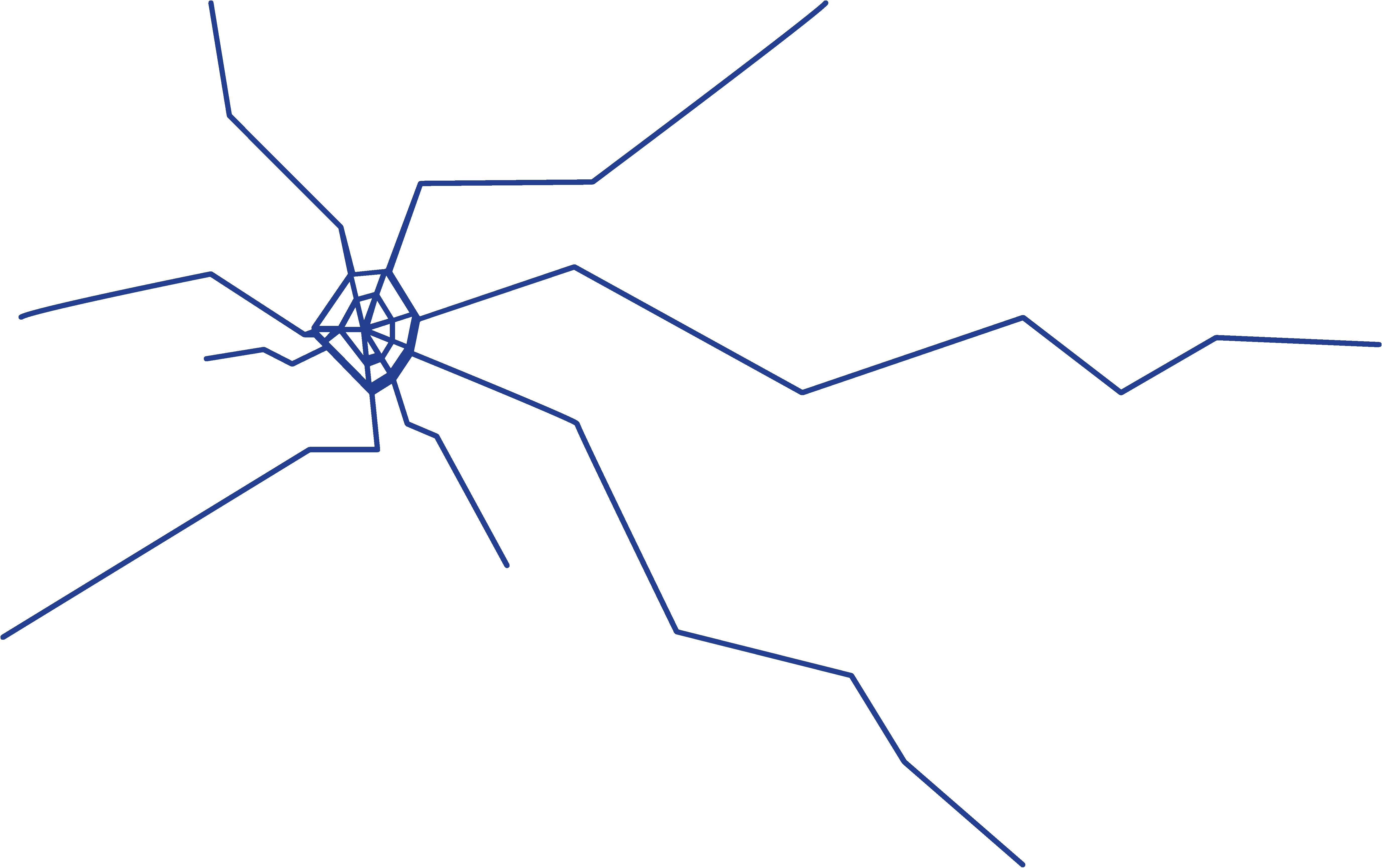
Picture the feed of your favorite social media app. All seems well as you scroll, until you come across a video of yourself that you don’t remember taking.
You hit play, but the person on the screen starts moving in a way you don’t recognize. To your alarm, the person on the screen begins taking off their clothes.
In June, this became reality when Grok, the generative artificial intelligence model featured on X, reportedly allowed users to produce sexualized content of real people, which some used to target and harass outspoken female rights advocates.
One of the women targeted on X spoke anonymously to USA Today in July, expressing disgust and a feeling of helplessness knowing people could generate these images without her consent.
She faced image and text-based abuse on the platform, with one user successfully prompting Grok to write a story in which the user sexually assaulted, beat and murdered her. Other X users bypassed Grok’s image generation censorship by asking it to recreate one of her photographs with hot glue dripping down her face.
Another woman anonymously reported her experiences in August to BBC after 25-year-old Callum Brooks was charged in Scottish courts for using deepfake technology to place her face on nude pictures. He was fined £335 for the charge of disclosing intimate photographs without consent.
The woman said Brooks’ actions made her feel betrayed, humiliated and small.
The official term for disbursing sexual images or videos of someone who has not consented is nonconsensual distribution of intimate imagery (NDII), but regulations struggle to adapt to artificially generated materials.
Arizona is one of 46 states to pass legislation addressing deepfake technology and nonconsensual imagery, adopting three senate bills and
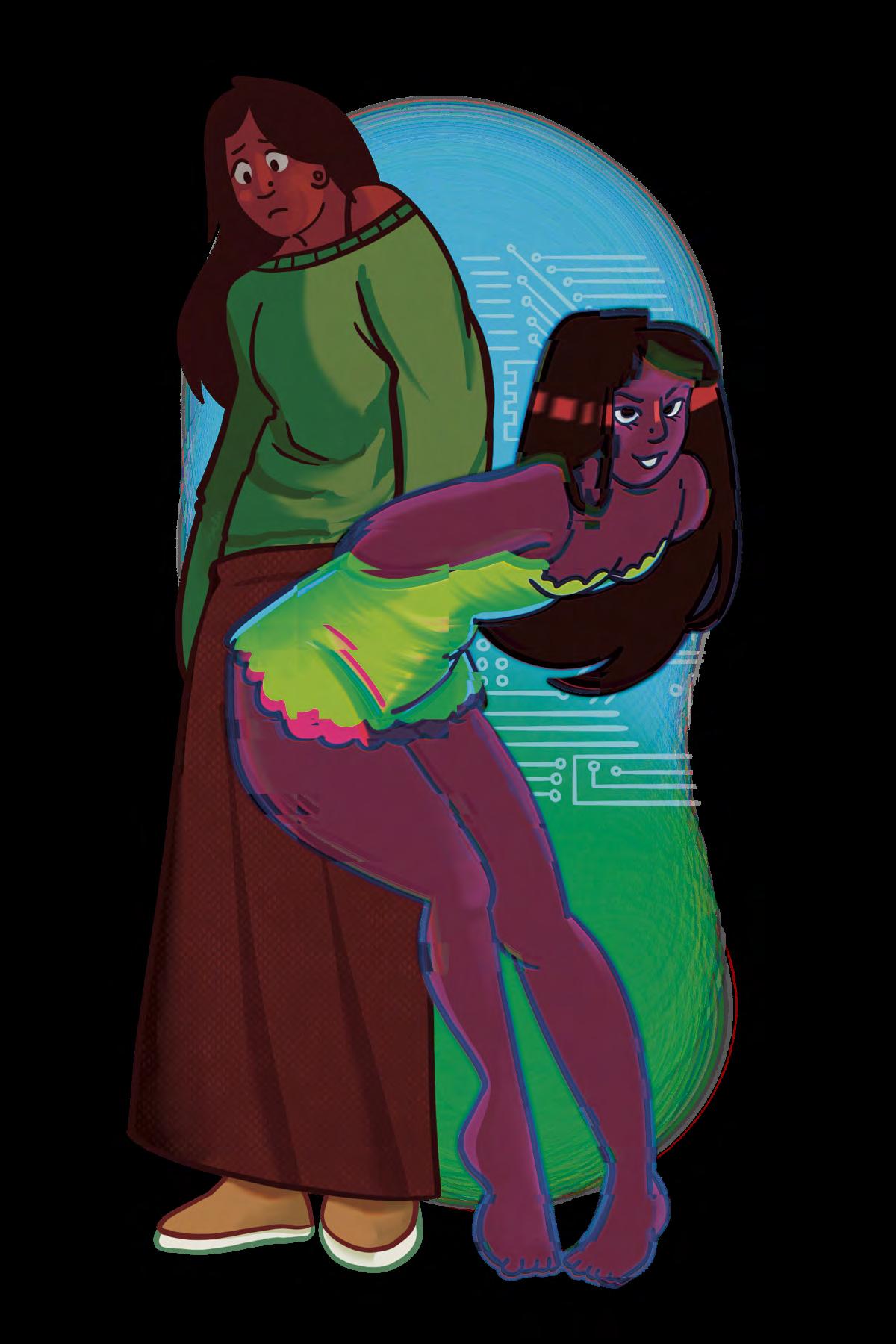


two house bills between May 2024 and May 2025.
Notably, SB1462 stipulates that if sexually intimate imagery is computer-generated, the person depicted does not need to prove their reasonable expectation of privacy for the images to be considered illegal.
However, legislation has not stopped many smaller companies from advertising undressing features for users to create and spread sexualized videos from an image. In August 2024, the San Francisco city attorney’s office filed lawsuits against 16 websites offering deepfake undressing features and banned 10 of the web services in California.
San Francisco City Attorney David Chiu said a primary reason for the lawsuits was an incident where students at Beverly Vista Middle School used deepfake technology to create fake nude images of classmates.
Marco Aurelio Gerosa, professor at the NAU School of Informatics, Computing, and Cyber Systems, said it was only a matter of time before people started using generative AI for pornographic purposes.
“Every technology that allows users to create content or publish content will be used for pornography,” Gerosa said. “It happened in the past. It will continue to happen in the future.”
Gerosa said there is no single solution to the problem of artificially generated nonconsensual imagery, and addressing it will require changes to AI technology infrastructure, justice systems and education methods.
Google announced new measures against NDII on July 31, including guidelines for reporting artificially generated sexual imagery and flagging it for removal.
However, in June, the Center for Democracy and Technology released an analysis of the issue, examining reporting procedures and victim support across eight other major platforms like Instagram, Facebook and Discord.
While data varies between companies, the report identified inconsistent policies, barriers to reporting and insufficient responses to artificial NDII in all eight platforms.
Carla Wilson, assistant teaching professor in NAU’s Department of Women’s and Gender Studies, said one of the immediate concerns around this technology is how it can alter sexual expectations.
“I definitely think that it causes not only unrealistic beauty standards, but also just unrealistic expectations,” Wilson said. “Unrealistic expectations or knowledge of sex, for one, and what is involved in the emotional components of it.”
In the case of generative NDII, if someone falls short of another’s expectations, they could potentially be targeted and harassed with artificially generated imagery.
Wilson said it is possible to use AI ethically and responsibly, but people need to discuss and teach alternative methods of interacting with these systems.
“Whatever new technology we have come across has always been
I definitely think that it causes not only unrealistic beauty standards, but also just unrealistic expectations. Unrealistic expectations or knowledge of sex, for one, and what is involved in the emotional components of it.
— Carla Wilson
harnessed for exploitation, but I would like to add they have also been harnessed for resistance,” Wilson said. “It’s not only exploitation. We can use these technologies to resist. We can use them in our favor. I just think that it needs to be taught.”
One method of using technology to combat NDII, Wilson said, is programming AI models to detect and prevent such imagery.
To address this issue, companies offering generative AI features will need to create specialized intelligence models designed to detect and remove illegal content.
“You can put AI in the loop to help detect this kind of imagery and remove it at multiple levels,” Gerosa said. “At the beginning, avoid creating. If it’s created, avoid publishing. If it’s published, avoid dissemination. If it’s disseminated, have ways to mark it, flag it and remove it, and that’s in terms of the whole pipeline of the technology.”
Adobe, Anthropic, Cohere, Microsoft and OpenAI agreed in September 2024 to remove nude images from their training data “when appropriate and depending on the purpose of the model,” according to a White House announcement condemning image-based sexual abuse of children.
This agreement is entirely voluntary, and the companies provided no quantifying guidelines for identifying appropriate content.
Former President Joe Biden’s administration made the announcement as part of a larger campaign against artificially generated imagebased sexual abuse, but it is one of the few issues to receive bipartisan consensus post-administration change.
President Donald Trump signed the Take It Down Act into law a year later in May 2025, making it illegal to publish nonconsensual, sexually explicit images or videos.
Although legal regulation and corporate policy will be useful in fighting against artificially generated NDII, Gerosa said there is little chance of eradicating the problem completely now that AI technology is widely available. Educating the public and widespread discussion of the issue remain crucial.
“I think it’ll get worse,” Gerosa said. “A lot of things will get worse with AI, and a lot of things will get better with AI, which I believe will

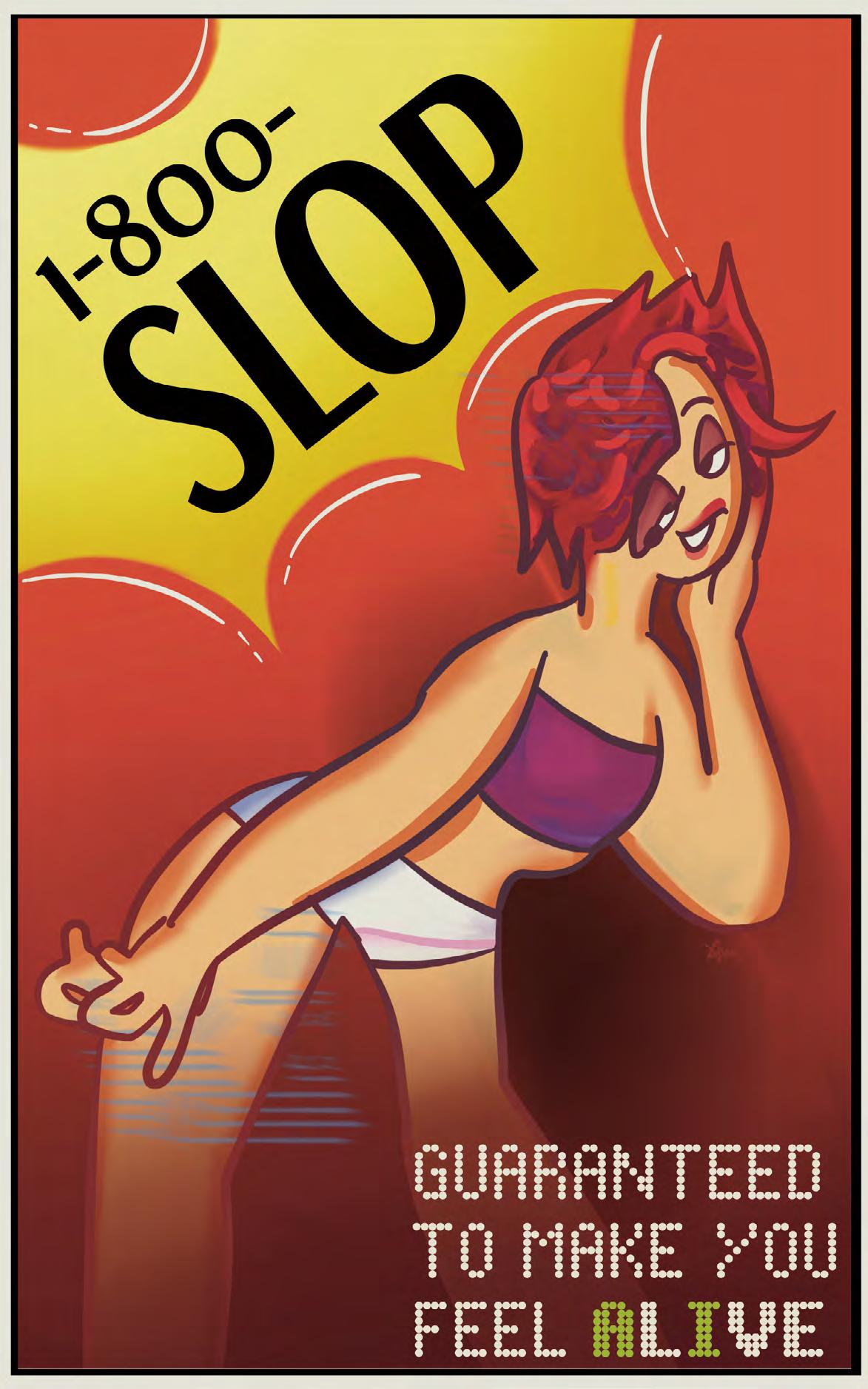
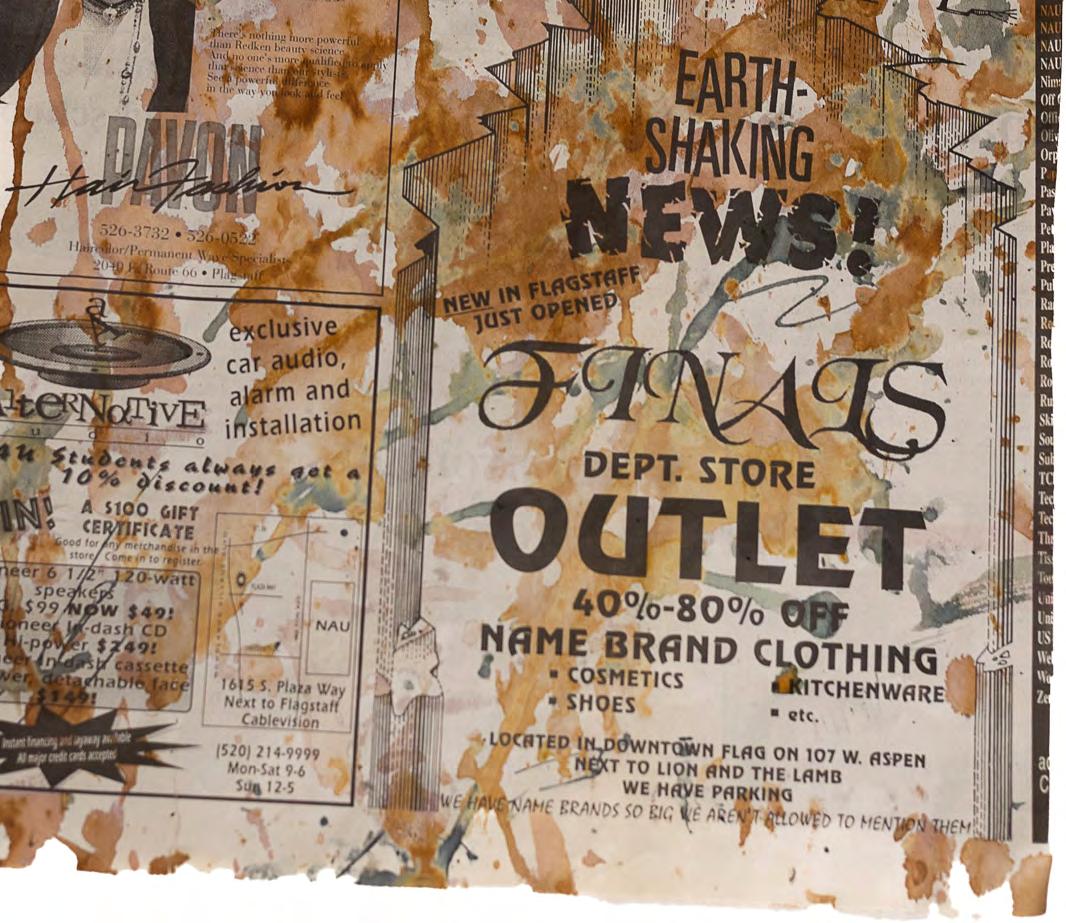
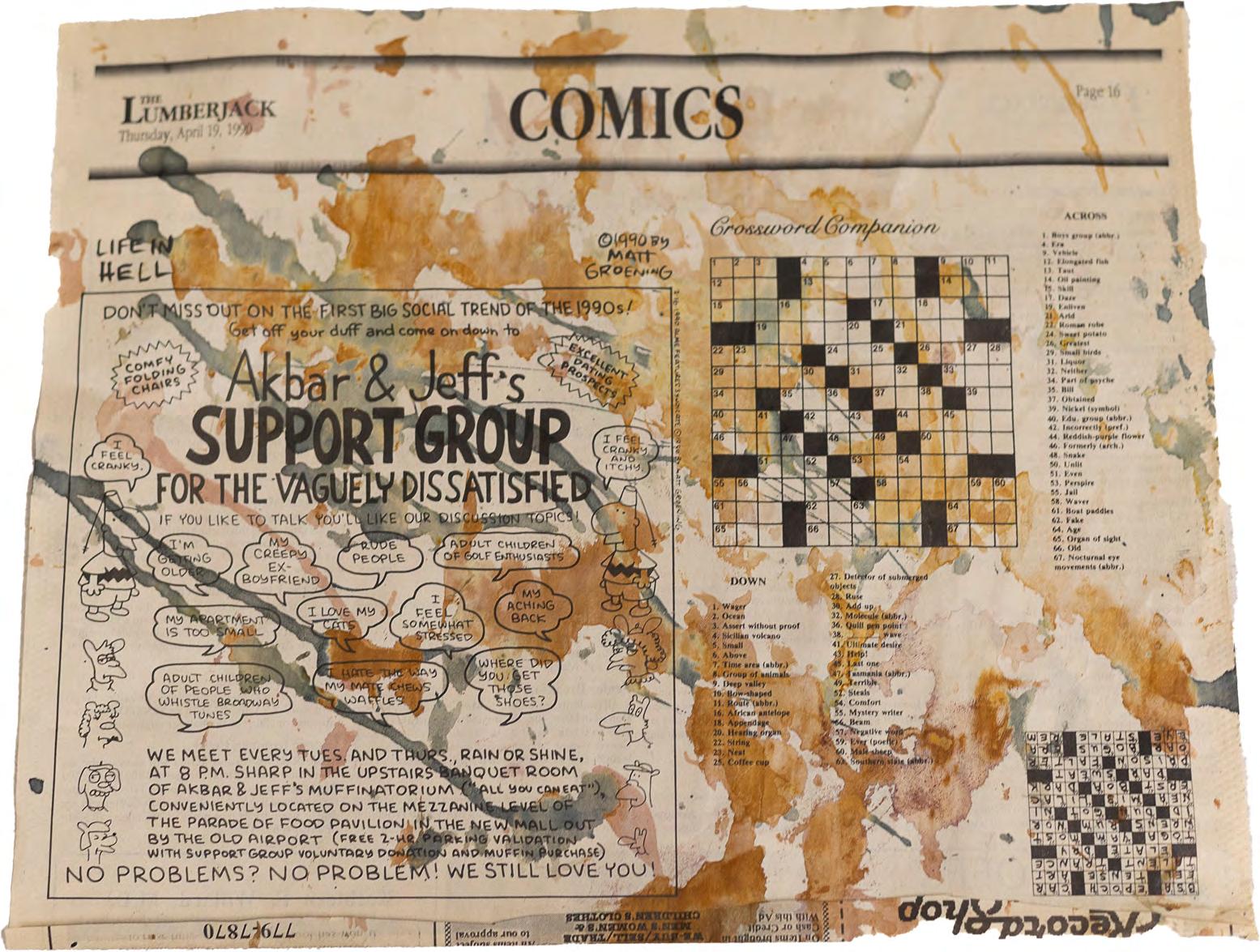

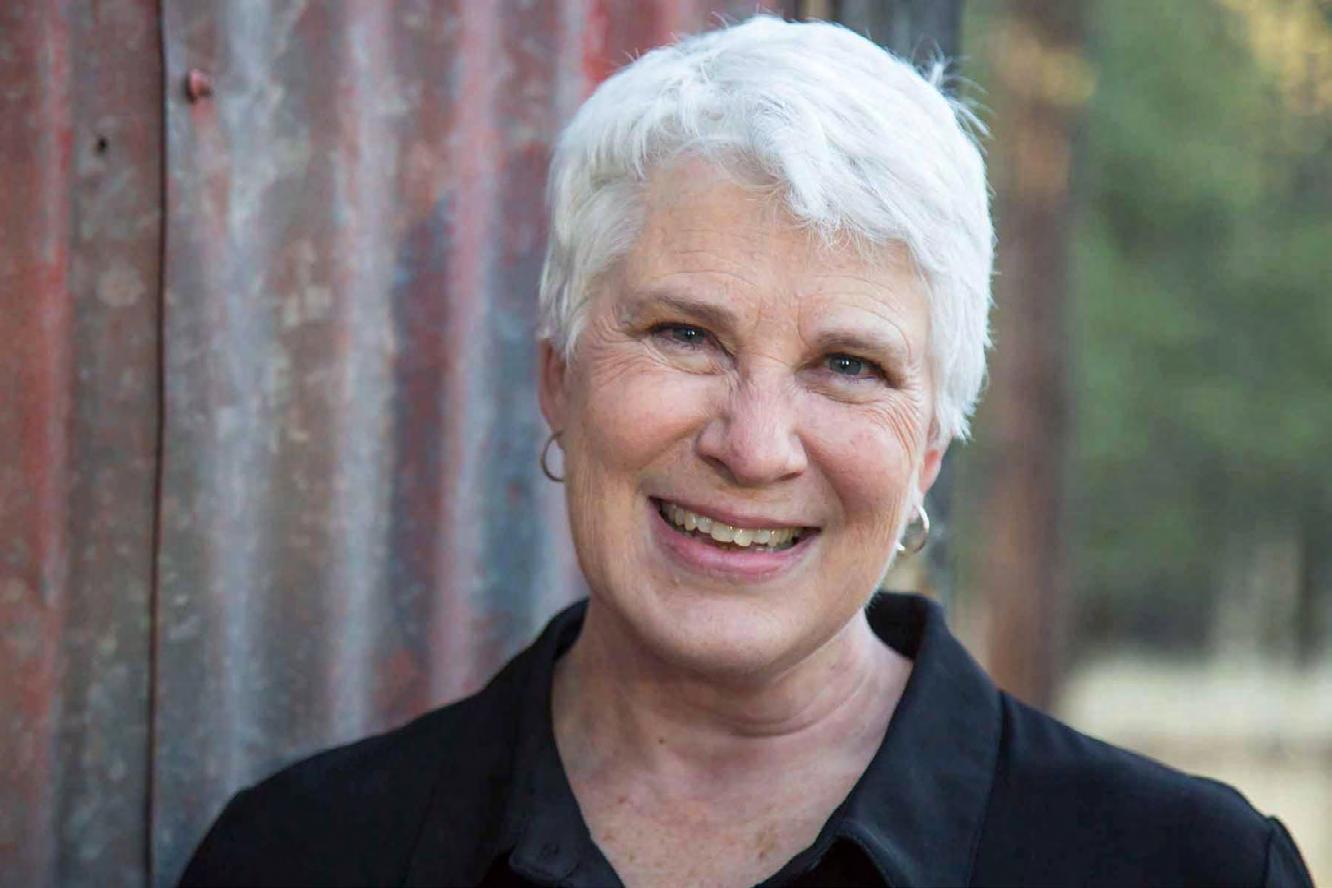
Story by Saige Steele
by Haleigh Williams
You scroll through social media and there she is: the perfect “pristine” mother and wife.
She has a six-step skin care routine and perfect blonde hair. She cooks in his custom kitchen, making homemade meals and baked goods while simultaneously keeping the house tidy and navigating multiple young kids.

She is the “tradwife,” the poster woman for what you should be one day. She presents herself as ridiculously happy, and her comment section aspires to be like her. This woman is the conservative fantasy — but she isn’t real. Conservatives are targeting young women and demeaning their choice to stray from the “nuclear family.” Women are ditching
the limiting traditional gender roles for their independence, going against the Christian nationalist controlling agenda.
Groups like “MAGA” and Turning Point USA (TPUSA) are successfully conveying the tradwife lifestyle to young women.
After President Donald Trump won his second term in office, misogyny rose across
the nation. MAGA men coined the phrase “your body, my choice” after the overturning of Roe v. Wade, one of the most embarrassing displays of incels coming together to attempt to prove they hold more power than women in this world. The current administration continues to undermine the rights of everyone who is not a straight white male.
The self-dubbed “fertilization president” has a long history of directing derogatory comments toward women, using language like “nasty” or “pigs” to attack his female political opponents or women who challenge him. Trump has also used money to silence women to keep them out of the press and keep his long list of sexual assault allegations from

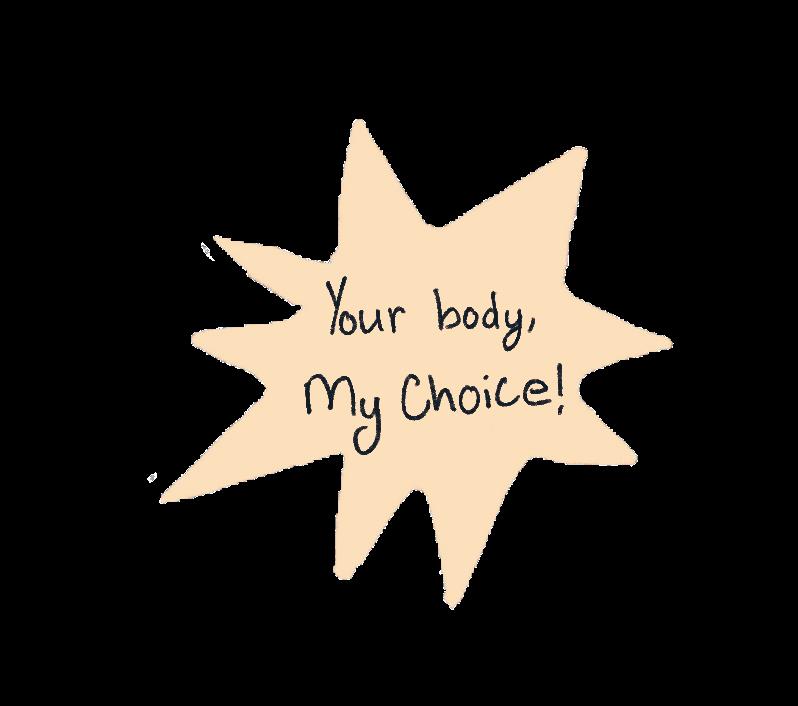
growing.
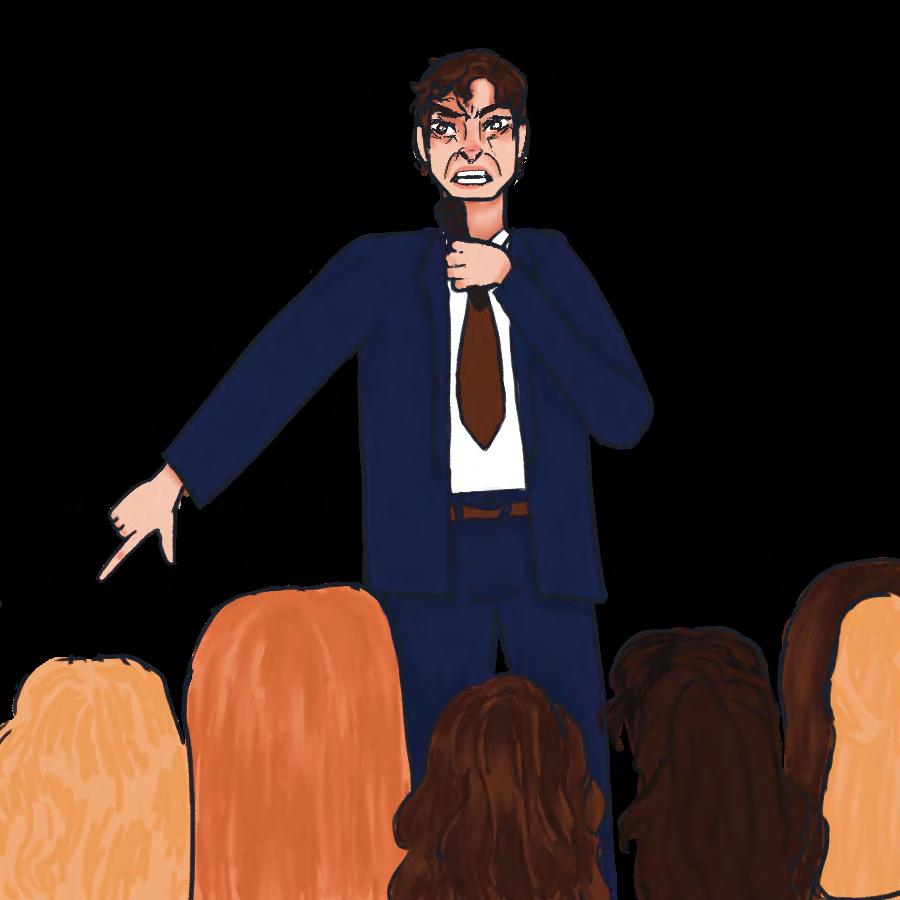
All his condemnable behavior doesn’t seem to sway his voters’ support.
The Trump administration and their fellow fascist followers have been crucial in pushing the regression of independent women and feminism.
They want women to be seen, not heard.
The far-right organization, TPUSA, held a Young Women’s Leadership Summit in June 2025 in Grapevine, Texas, to promote its conservative agenda to young women. The summit was filled with biased, unethical, antiwomen speakers, like Candace Owens and Alex Clark, who promote the rigid gender roles that undermine a woman’s choice and sense of independence.
The speakers framed traditional gender roles as empowering and real feminism while hiding the controlling and limited ideas they really are.
“You are witnessing a cultural revolution,” Clark stated as she opened the brainwashing summit. “Less Prozac, more protein. Less burnout, more babies. Less feminism, more femininity.”
TPUSA serves the Christian nationalist agenda and takes advantage of young women who are looking for support. They gaslight them into abandoning their hopes and dreams to get them back in the kitchen and join their
cult of brainwashed anti-feminists.
During a Sept. 8 Fox News segment called “Ingraham Angle,” the host asked Charlie Kirk, “What’s going on with women and not wanting to prioritize family?” Kirk then proceeded to bash women while uplifting men.
“Trump voters, young men, want family, children and legacy,” he said. “Young women who voted for Kamala Harris, they want careerism, consumerism and loneliness.”
Hearing an evangelical Christian declare this is not surprising, as half his brand was telling women to submit to their husbands under the name of “God.” He even told young
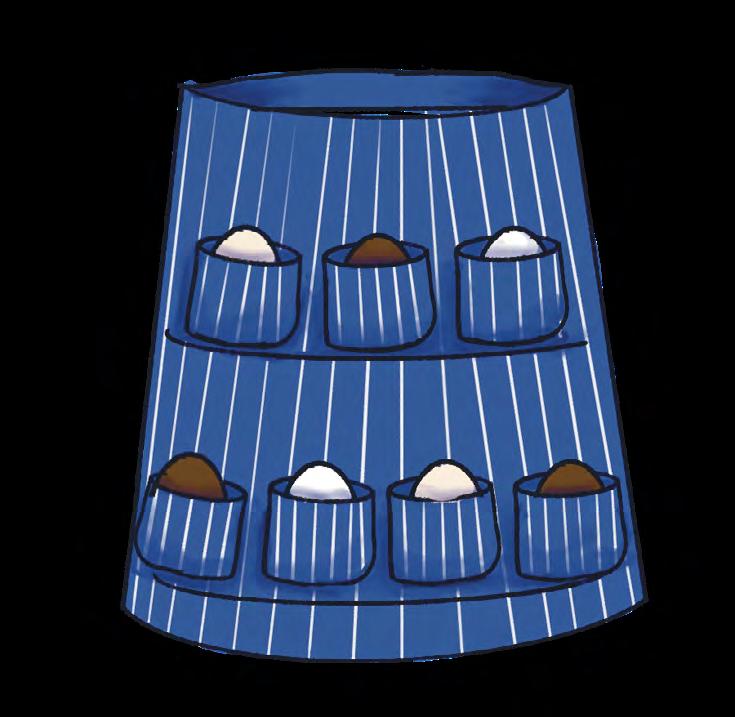

women to their faces that they should go to college for the M.R.S. degree to get a husband, not a career.
After Kirk’s assassination Sept. 10, his wife, Erika, announced she will take over the TPUSA foundation as the new CEO. She plans to continue his “god-centered” misogynistic message.
She gave a long speech about how men need to find Christianity and women need to recognize their “godly design” as mothers and wives.
Hannah Neeleman, “queen” of the tradwives and member of the Church of Jesus Christ of Latter-day Saints, is the picture-perfect example: a stay-at-home mom with eight young kids. She traded in her professional pointe shoes for mud boots. She left The Juilliard School in New York City to get married and have kids and run an expansive farm in Utah.
She married Daniel Neeleman, whose father founded the airline JetBlue, making him nothing short of an airline nepo-baby and able to provide generational wealth to sustain a large family.
When watching these women on social media, you would never know they just came back from performing hard, time consuming tasks like milking a cow or baking from absolute scratch. This homestead farm life

presented effortlessly and preaches self-sufficiency.
Their natural domesticity is a silent protest of modern day consumerism and to subtly say, ‘I can do it all,’ all while perfectly manicured.
Living on a farm, gardening and cooking from scratch requires hours of dedication and is not a clean job. Actual farming is exhausting. You can’t garden without getting dirt under your nails and mud on your boots, nonetheless Hannah’s performative flannel goes unscathed.
Watching Hannah not have to hold down a 9-to-5 job and live far above the means of the everyday woman is appealing, but Hannah’s style of living shouldn’t be the standard, nor is it realistic.
She has given up her dreams for her husband’s dream of a big family and prepared dinners and a clean house, which is probably cleaned by a maid because who would have the time?
I imagine it would also be lonely, only surrounded by children who you are constantly at the beck and call for, unless you have a fulltime nanny, with your husband constantly stuck at the office to support this lifestyle.
The woman cannot obtain the tradwife persona unless she wants to sacrifice her dreams for the household. Being a tradwife is elusive and only exists to the wealthy and white.
It is one thing for partners to make the conjoined decision for the wife to stay home, but to tell women that’s the only thing they should aspire to is plainly outdated.
Social media romanticizes the era of the traditional wife that was born out of white nationalism and racism. Only white middleclass women were allowed to only work in the household, women of color were still expected to work for low-wages.
The tradwife movement sets the example to women and young girls that their independence is overrated and what they want will never be as important as being a good wife and mother.
As a woman who prioritizes my independence and personal goals over settling down, having kids and putting myself on the back burner to join the nuclear family would be a disservice to everything I continue to work for. It would be more demeaning to bow down to a husband telling me to bear his kids and have dinner on the table by six.
All conservatives really want is to increase the birth rate and keep power in the hands of men. In the U.S., women are having fewer kids or none at all. According to Pew Research Center, women ages 18-49 reported they ‘just didn’t want to have children,’ with other reasons ranging from they wanted to focus on other things or they couldn’t afford to.
Women today don’t feel the societal pressure to get married and settle down. They are prioritizing themselves and conservatives aren’t happy with that as it undermines the ‘white male’ hierarchy. With women not afraid anymore to be an unashamed working mother, or not a mother at all, men aren’t able to be the ‘big, strong, provider’ they need to be to fulfill their ego.

are actively working to take down women who challenge them.
Realistically, if these performative tradwives really wanted to practice what they preach, what the tradwife trend is born out of, they would not be posting and profiting off of social media. Their time spent prepping their makeup and the perfect slick back bun to be camera ready takes away the dedication to their domestic life
This tradwife fad should be just that: a fad — a short-lived lapse in judgment, not the gold standard end goal these misogynists want. Society owes women the respect to progress past this idea of a pristine woman.
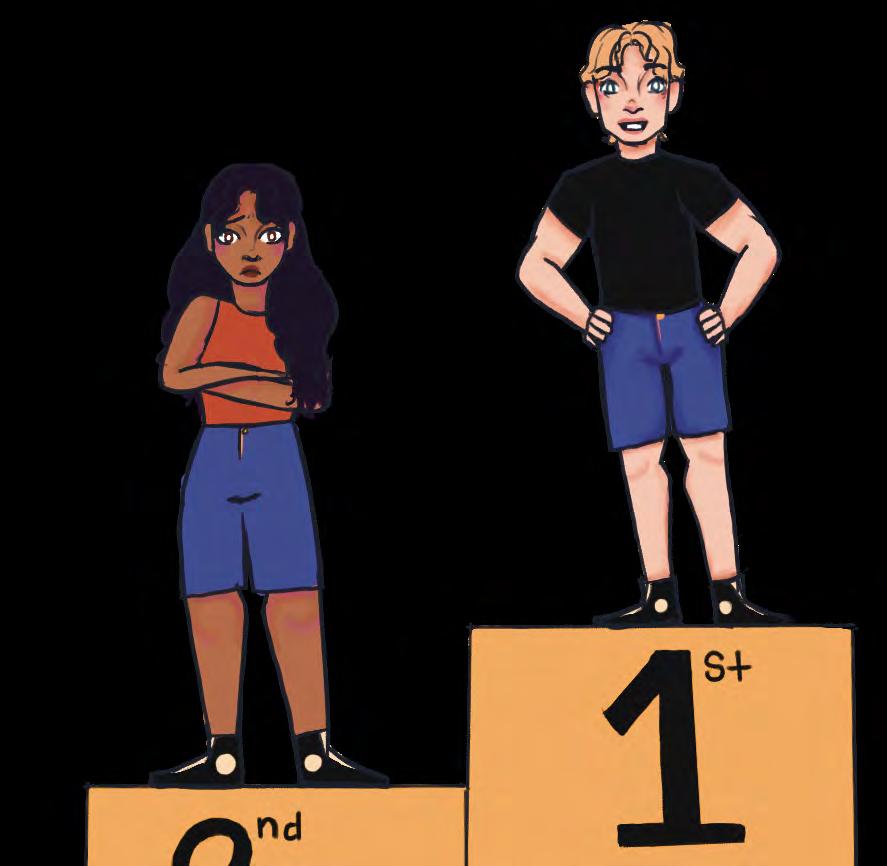






Flagstaff alternative music spans beyond stereotypical images of the brooding emo or the angry punk. Bands across northern Arizona showcase the complexities of what it means to be alternative, bringing dimension to the long-defamed label.







Awoman bashes the drums while a man next to her rhythmically strums his trusty bass. Both musicians, in all of their glory, are adorned in radiant turquoise.
The siblings are in complete harmony, moving the masses through their personal, powerful and unapologetically Indigenous music.
This is Sihasin: siblings in sound and arms.
Sihasin — formerly known as Blackfire — is a Diné punk rock band started in Black Mesa, Arizona, by siblings Jeneda Benally, Clayson Benally and the late Klee Benally.
From a young age, the Benallys aligned themselves with resistance and social justice. They rooted their earlier music in their Indigenous upbringing and experiences of oppression.
“We grew up protesting,” Jeneda said. “We grew up knowing that our voices were powerful tools.”
Growing up learning from their community’s consistent fight for sovereignty and stewardship, the middle-school-aged trio formed Blackfire in 1989 with a fervor for rock music and a desire to use the genre for empowerment. Clayson said Blackfire was an outlet for the group’s anger regarding antiIndigenous acts they witnessed throughout their youth.
Indigenous people in America have witnessed generations of genocide, forced assimilation and displacement that continue to affect their communities culturally, spiritually and socioeconomically.
“That process of forced removal and hearing the government say you’re trespassers, that you don’t belong on this land, as a child, that does a lot to you,” Clayson said.
Diné culture is rooted in music, with ceremonies involving instrumental and vocal elements to amplify participant well-being. The Benallys use their culture as an anchor for their music; a lack of formal musical training did not deter them.
Twenty-one years after starting the band, Jeneda and Clayson said they felt an energy shift in the band’s creative direction following a series of events on the Navajo Nation.
The Navajo Nation sued the U.S. Forest Service in 2007 for Arizona Snowbowl’s use of reclaimed wastewater. Although the court case went to the 9th Circuit Court of Appeals, the case ruled in favor of the U.S. Forest Service, the Navajo Nation lost the case as a result.
During this time, the number of youth suicides on the Navajo Nation rose, according to the Arizona Department of Health Services. One case involved a 13-year-old girl.
“It broke my heart,” Jeneda said. “It broke my soul, my core being, that a child couldn’t find hope in this world.”
Those events inspired the group to change the band’s name in 2012 to Sihasin, “Hope” in Dinè. While their previous sound was filled with rage, Sihasin’s new sound is warmer,

inspiring change through positivity.
Clayson said Blackfire had a more angry sound, coinciding with the late Klee’s anarchist views. A lighter sound allowed Sihasin to recenter Clayson’s traditional views of Indigeneity in the music.
The band revitalized the importance of community, beauty and harmony that seemed lost in translation during Blackfire’s tenure. Sihasin now tours the U.S., redefining the use of its platform to help its communities statewide.
The band has worked with other artists and coalitions, like hip-hop musicians and former Black Panther Party members, to amplify messages of resistance against colonialism. Sihasin also worked with the U.S. Embassy to bring global awareness to the genocide of Indigenous communties.
Although it is
controversial for alternative bands to work with the government, the Benallys understand there is no one right way to resist oppression or to help their communities.
“We need to have a seat at that table,” Clayson said. “We need to have our voices heard.”
The Benallys have not forgotten their community at home. Sihasin still performs local shows in Flagstaff, amplifying their messages of hope to the people of northern Arizona.


Drag culture and alternative culture go hand-in-hand. Both have resistance at their core, whether it be musical or physical.
The drag performance art has a rich history in America, starting in the 19th century and becoming prominent in the 1960s. It became an act of protest during the 1990s to decry anti-LGBTQ+ regulations in the U.S. Alternative drag combines both cultures by incorporating all things “weird” and “unorthodox” into dramatic costumes and makeup. Flagstaff drag performers embody this style, transcending the set norm of drag performance and experimenting with the concept of gender identity.
Drag performer Lilith Gore adorns herself mostly in black. Every so often, she adds splashes of red to her ensembles for a vampiric, undead look.
In her performances, she traps her audience with an icy stare. Gore’s slow, calculated and unnatural movements match her brooding goth-punk soundtrack, a departure from the upbeat pop songs many popular drag performers gravitate toward.
Although it is haunting, her style is unique. Most importantly, it is Lilith Gore.
Gore is relatively new to the Flagstaff drag community, but her dramatic stage presence and unnerving aura have taken the scene by storm. Gore started doing drag in 2024 as part of NAU’s student-led drag collective, FLAUNT.
Gore said she once identified as nonbinary; only after joining FLAUNT did she consider the possibility of identifying as a transgender woman. Despite her willingness to embrace her differences, Gore said she knows it is not widely accepted to exist outside the norm. America’s political climate actively punishes individuals who do not fit Western, Eurocentric standards, and Gore believes people are scared of change.
With these beliefs, Gore said being alternative and doing drag is inherently political, and choosing to survive as an alternative queer person is an act of resistance in and of itself.
“Anything that’s ‘not normal’ is alt in my opinion,” Gore said. “If you look at the examples of alt, you think of emo, you think of goth, you think of punk. But I think anything that’s considered different is considered alt.”
Gore said “othering” is common within Flagstaff’s alternative community, as insecurity is prevalent and people fear they do not fit the ideal alternative image. For Gore, this is reminiscent of what conservatives, or “the enemy,” in her words, do to others — shaming people who are not the set mold for alternative culture.
“I think what it means to truly be alt is to accept those who are different, no matter what,” Gore said. “I’m not a Christian, but my mom is. She tells me all of the time, ‘love thy neighbor,’ and that in of itself is alt.”
Alternative drag artists often use their performances as an extension of their physical, emotional and mental selves.
For Miasma, alternative drag is where she thrives. Her performances are best described
as something out of a horror movie; her drag looks embody grotesque body horror and eccentric facial expressions.
She keeps the crowd on the edge of their seats, using nightmarish imagery inspired by films like “The Thing” and “The Fly.”
Whether it be an erotic fish lady or a creature with pins and needles sticking out of her body, Miasma’s monstrous looks have all eyes on her.
Miasma began her drag journey attending shows in downtown Flagstaff. Seeing other drag queens perform lit a fire under Miasma, inspiring her to perform with FLAUNT before venturing off on her own.
She is constantly creating new and fresh routines; Miasma’s inspiration for every set stems from a song she hears. Although she pulls inspiration from alternative music and horror movies for her drag routines, her main goal is to embody pain and suffering through body horror.
“Being trans, you don’t always feel beautiful,” Miasma said. “In fact, you often feel very ugly. I like to explore those themes of feeling like I’m in the wrong body, like I want to get out of my own body, like I am ugly. Then, I want to find beauty in ugliness.”
Miasma incorporates political themes into her work through unnerving and sometimes erotic avenues. She depicts these complex themes through her jarring choreography, allowing the audience to focus on the messaging behind her eccentric routines.
After President Donald Trump’s reelection in 2024, Miasma performed the song “I’m Afraid of Americans” by David Bowie, written to criticize American imperialism, at venues like The Hive and Hotel Monte Vista.
Miasma’s interpretation of the song embodied the fears she had as a trans woman under Trump’s administration.
Despite the fears and concerns she holds as a trans woman and drag performer, Miasma uses performance as a way to cope with her negative emotions. She hopes that her drag inspires others within the LGBTQ+ community to be open about their mental health struggles.
“It’s okay to be loud in public with your pain,” Miasma said. “By being loud, public and vulnerable with your audience, you open yourself up to making people feel comfortable with those emotions in their own lives.”
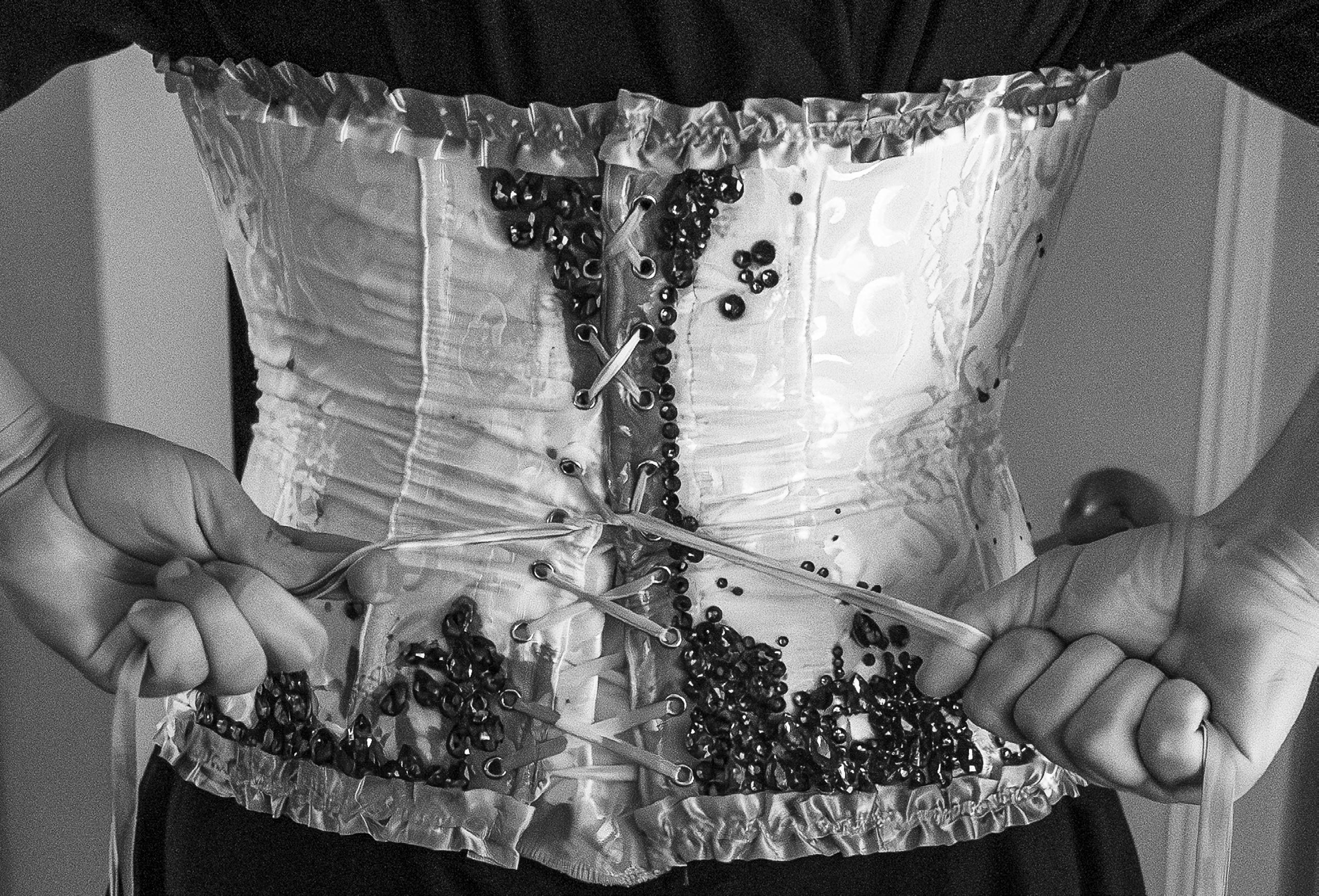
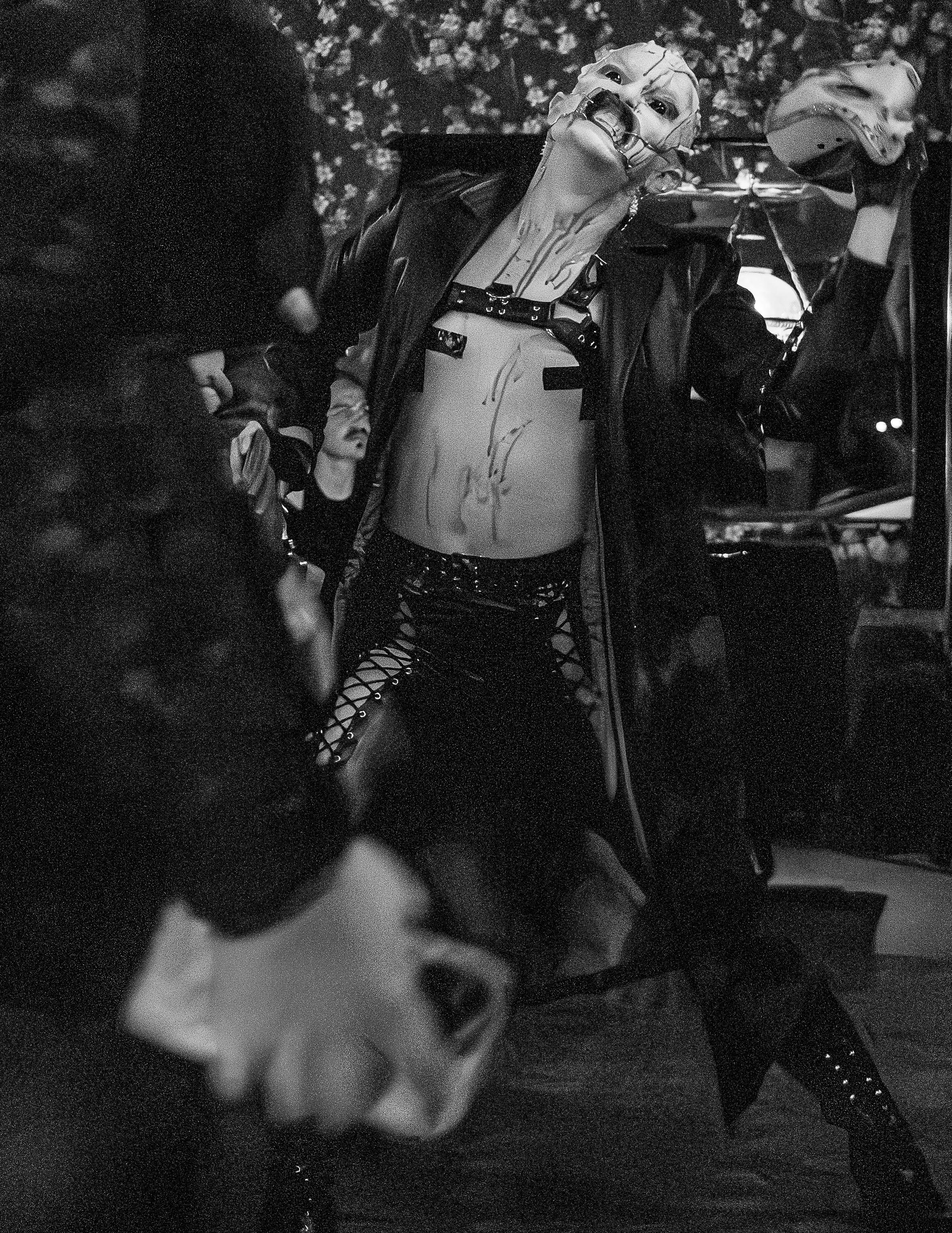
It’s okay to be loud in public with your pain. By being loud, public and vulnerable with your audience, you open yourself up to making people feel comfortable with those emotions in their own lives.
— Miasma
The dancefloor is filled with black-clothed patrons moshing and laughing, people enraptured in the flashing lights and brooding atmosphere.
Despite the thematically dark space, this venue breathes life into Flagstaff’s alternative scene, bringing together people from all walks of life.
This place of obscurity and mystery is The Batcave. The underground alternative lounge is located at Firecreek Coffee and is affiliated with the collective Firecreek After Dark After Firecreek Coffee’s business hours, the coffee shop opens up the space to host latenight events.
Sonni Pinto, head organizer of The Batcave, wanted to bring the Flagstaff community together through expressive dance and angsty music.
Alternative music has always impacted Pinto deeply, specifically underground and industrial songs. Although Pinto has never personally connected with a specific subculture, the music’s subject matter drew him into the genre.
Pinto created The Batcave, a welcoming space for a variety of goth subcultures, in response to the marginalization he experiences as an Indigenous and LGBTQ+ person. The space uses gothic inspiration, paying homage to the 1980s London nightclub it was named after.
“We can go in there, and we can wear dresses,” Pinto said. “We can wear our ‘war paint’ as I like to call it, the black, and be as bats and accept everyone.”
Although he loves the mainstream DJ scene, Pinto said he often notices an absence of empowerment and dark subject matter in the music. Pinto pushes for alternative music rooted in lyricism, bringing in DJs and alternative bands who hold those core values and play classic goth music.
“The classics back in the day were a lot of songs that spoke to a generation, like way deep,” Pinto said. “It was poetic, it was dark and it’s the right time to bring that back out right now because we’re fighting for our rights.”
Kelley Nez, known as DJ Frankenstein, is a Diné DJ who performs at The Batcave along with drag performers and local Flagstaff bands.
Before her tenure with The Batcave, Nez DJed with Peaks Audio Productions, a Flagstaff-based entertainment and audio production company. Nez worked as a sound engineer before moving to DJ gigs, primarily performing at weddings and fundraisers.
Nez stayed with Peaks Audio Productions for a year until the COVID-19 pandemic, left her unemployed. To stay afloat, Nez worked in the cannabis field and taught herself how to DJ while quarantined. Eventually, Nez purchased a DJ kit and forged her own path as a selfmade artist.
As an Indigenous youth, she grew up in tune with the music scene, always looking for local bands and their next performances. Nez’s musical influences stemmed from her parents who played ‘80s rock artists like Iron Maiden and Twisted Sisters throughout their home.
These influences led Nez to find her niche in the Indigenous metal genre, drawn to the vibrant Indigenous punk scenes downtown and on the reservation.
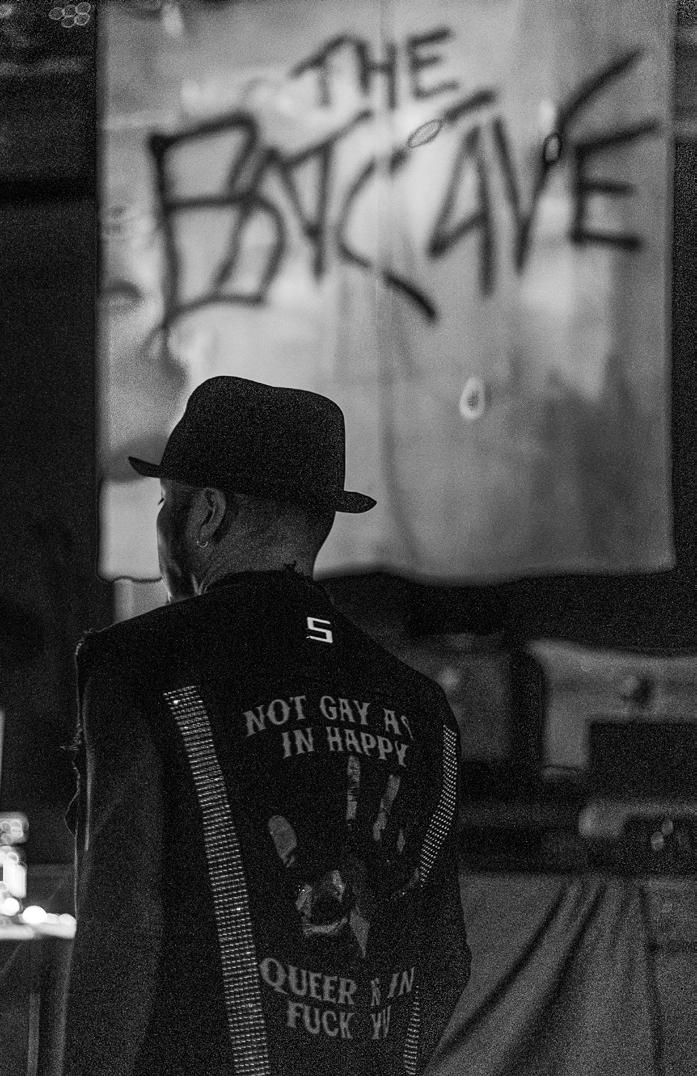
“I really love music,” Nez said. “I love the shiver it gives down my spine. I’m never going to forget that feeling. There’s something special about that, and I can feel it.”
As a Diné woman, Nez wants representation for the Indigenous community within alternative spaces. She said The Batcave and goth nights allow herself and other Indigenous people to embrace their Indigeneity while being alternative.
To Nez, The Batcave has served as a space for Indigenous people to decompress and leave their worries at the door. She said the space feels refreshing and needed, and wants others to feel that joy when they hear her music.
“I’m just a mom,” Nez said. “I’m just trying to do what makes me solid, what makes me happy, and this makes me happy. I think I need to share that, especially with this town.”

Join to earn class credit, gain field experience, build your portfolio with published pieces and master career skills.
The Lumberjack is always looking for:
• Writers
• Photographers
• Illustrators
The Lumberjack operates through a class-based enrollment system. If you are interested in reporting or visual production, please enroll in JLS 251 with Katherine Locke.
We are taking applications for:
• Director of design
• Director of marketing
Hiring will take place at the end of each semester for the following semester. Job descriptions and application information is available on jackcentral.org.

